
74 minute read
CRN
A bold personality that exudes sportiness and power. Clothed in an audaciously unique livery, Voice, a bespoke 62m, is a one-off vessel with bespoke technology and design which also reflects CRN’s DNA, as all CRN fully custom megayachts. A collaborative project with Nuvolari Lenard, the pen behind the concept and exterior and interior styling
Clearly designed to make her mark, Voice is a seafaring sculpture stretching 62 metres in length and 11.5 in the beam. It is quite simply impossible not to stop and admire her. Designing and building a yacht of this calibre demanpoint was a blank page on which the client could begin to create his vision. Endless meetings with the yard followed. It took more than 43 to hammer out the final details of certain lines which the owner wanted strong, aerodynamic, taut and fluid at once. Voice is, consequently, a ds impassioned commitment from both yard and designer. It demands powerful expression of her owner’s personality with an instantly recothe right rhythms and volumes to create a yacht with a boldly different gnisable profile even at a distance. The interiors too were designed down personality that also succeeds in being beautifully balanced. to the tiniest detail in the course of over 80 meetings with the team. Voice was both designed and built by CRN in collaboration with Nuvo- But on top of all this, the owner wanted a technologically advanced, lari Lenard which developed the concept and the interior and exterior high performance yacht that would also be comfortable and focus on styling. That work was done in very close contact with the owner, a very sustainability. decisive and exacting individual with a clear idea of what he wanted. Meticulous work went into designing the soundproofing aboard, for Voice’s sporty, dynamic and powerful soul is underscored by a series of instance, to guarantee substantially reduced noise levels seventy tonnes lines which gradually taper aftward from the bow into an arch which of insulating material were used – that is around double the standard seems to melt into the sea. These are soft curving lines clearly influenced amount for a yacht of this size. The owner is a great music lover also by car design, and contrast with decisive cues. so a studio- quality sound system was designed too and the onboard IT This entirely custom yacht has a custom livery that changes with the is equally advanced to guarantee cyber security and privacy standards light: the smoky quartz used for the hull, the silver sand on the super- certified by Lloyd’s Register of Shipping. structure and the jet black detailing are the result of over 35 samples From a performance perspective, Voice unleashes a top speed of 16.5 obtained by mixing four different types of metal. knots (the owner requested 16 in the contract) with a range of 5,500 Spread over five decks, Voice can welcome 12 guests – there are five VIP nautical miles. She avails of innovative technologies such as the full cabins in addition to her owner suite. She also has quarters for 17 crew. AUT-UMS system which allows the yacht to be controlled automatically The upper deck has been devoted to the owner with the suite itself aft without the chief engineer constantly supervising. and a panoramic saloon forward so that it can double as either a very CRN’s environmental and sustainable development strategy was mirroprivate area or a space to share with friends and family. That said, there red in Voice’s owner’s own concerns. The 62m is the first megayacht to are plenty of other social areas right throughout the yacht – the sun deck emerge from the Ancona yard to be awarded IMO Tier III certification, has a particularly large pool, in fact, that can be used underway also. which guarantees that noxious emissions from her engine exhausts have Voice is a unique creation in which design and technology go hand in been cut by 70%. She will be followed in this by other full custom yachts glove. She is the result of a meticulously gradual process. The starting currently in build. www.crn-yacht.com
Advertisement

Cutting an imposing stance on the water, this 62m has a steel hull and aluminium superstructure. The powerful, dynamic lines of her profile (opposite) are underscored by iridescent hull and superstructure colours that change with the light. She has a top speed of 16.5 knots
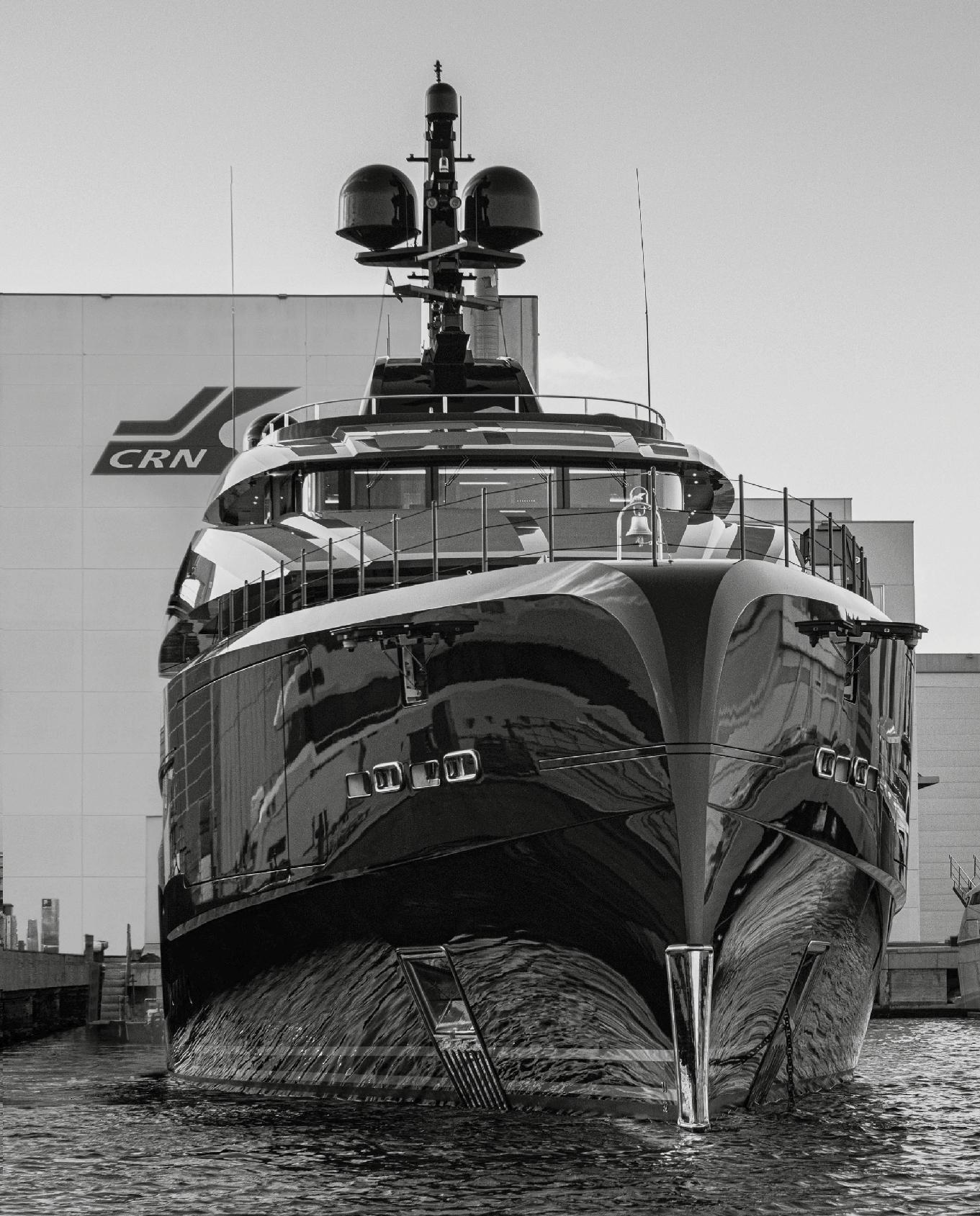



Voice’s various design and build phases. It took over 43 meetings between the yacht project management team and the owner to hone the final details of some of the yacht’s unusual exterior lines and more than 80 to design the interiors down to its finest points

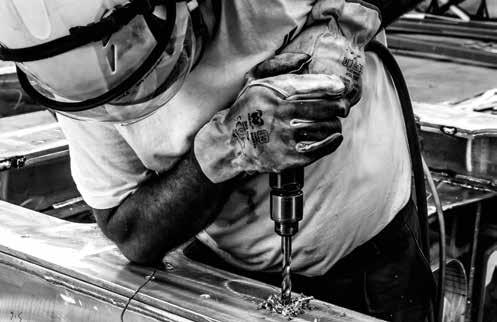
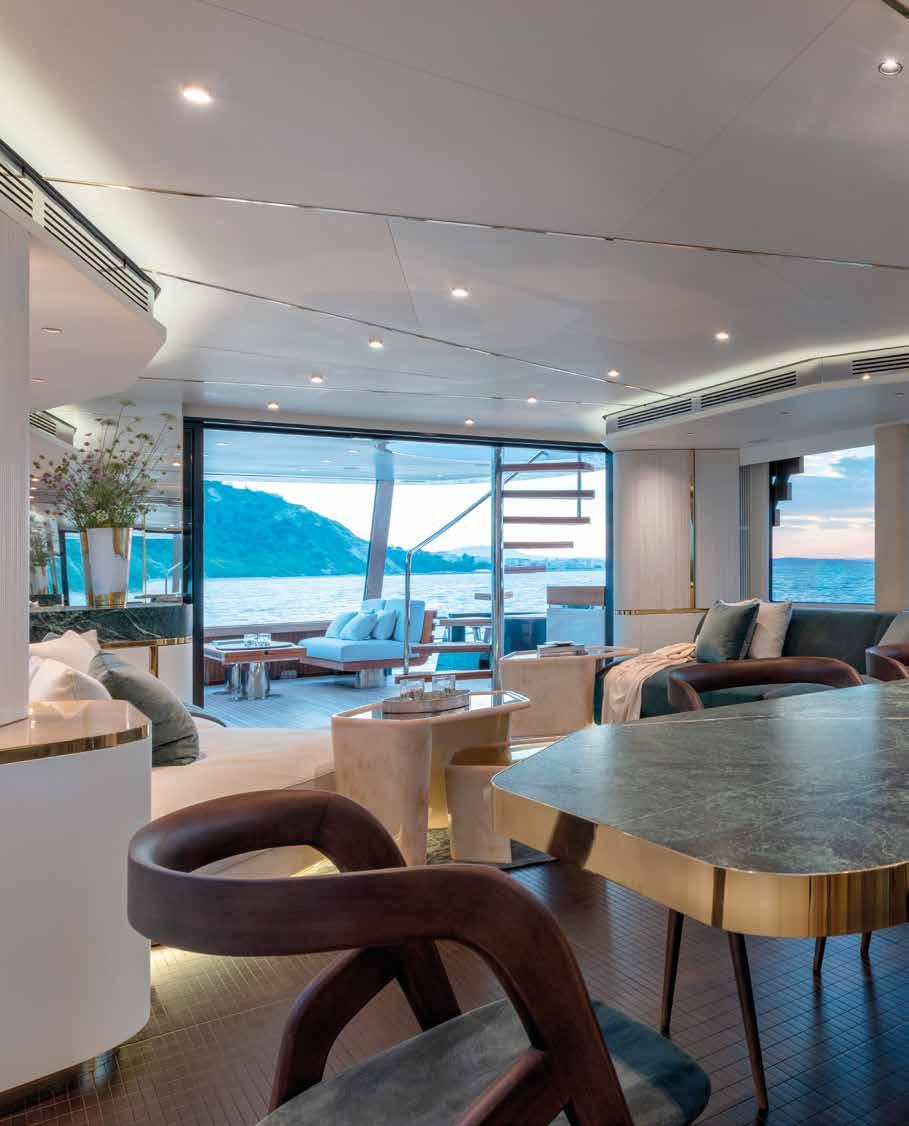
Brimming with surprises and the creative joint effort of two masters of design: Ken Freivokh (exteriors) and Vincenzo De Cotiis (interiors), it is one of the most fascinating Azimut Yachts. Because this is not a no-holdsbarred superyacht but a 25m displacement yacht designed to deliver long luxurious cruising with art a seamless part of the living space
by Marta Gasparini - ph. courtesy of Azimut Yachts
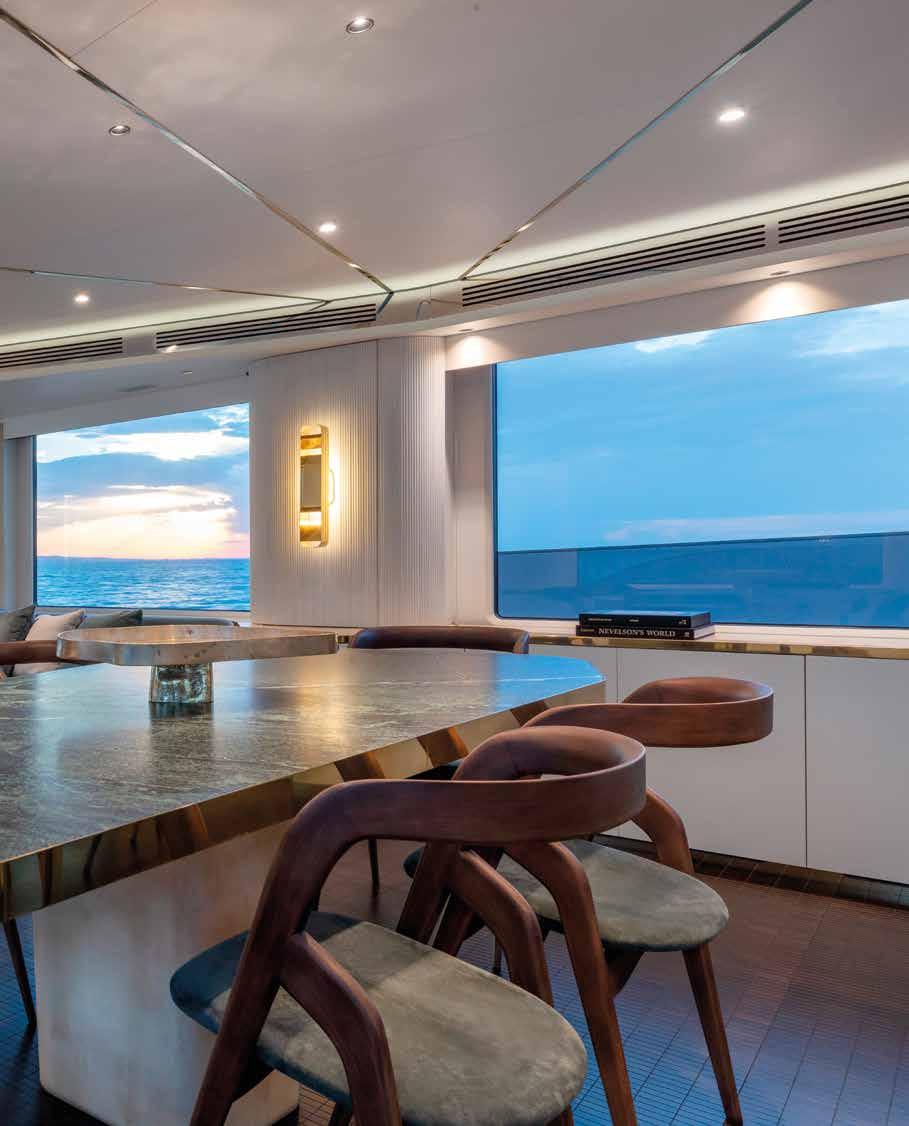
othing is quite as it first seems aboard the new 25m from the Magellano Collection. This first yacht to be developed with architect, designer and artist Vincenzo De Cotiis has a timeless and slightly surreal ambience. World-renowned for artwork that turns rough, raw materials into poetry, the maestro’s elegant stylistic approach here combines the likes of recovered fibreglass, stone and wood. The 25 Metri’s exteriors are the work of Ken Freivokh, already very much at home with Azimut having penned the very first model in the range, the Magellano 74. There are many striking elements to be impressed by, not least the glazed superstructure, the teak louvres at the end of the panoramic windows, signature Freivokh styling elements that personalise the aft section of the deckhouse, the spiral stairs leading up to the fly, the carbon fibre hard top surmounted by a single central element, the retro styling of the hull windows, and the cockpit that offers unobstructed views thanks to transparent bulwarks. The whole concept of “art onboard” in the interiors is taken to a new level. Forget about the saloons, cabins and suites you’ve seen before. These spaces are completely and utterly different. Entering the Magellano’s interiors is a unique experience. Guests are instantly immersed in a rarefied atmosphere with the sophisticated taste and ambience of a much larger craft. Freivokh has produced a stunning shell with the raised steering position/wheelhouse to create generous spaces and ensure a seamless transition between his work and that of interior designer and artist, De Cotiis. It was to this master of elegance and art that the yard entrusted the bare shell to imagine as he would. The result is a very particular stylistic language that takes its lead from concepts such as waves and the sea, resulting in soft forms that start at the entrance to the saloon and lead forward from there. This sense of spaciousness is emphasised and obtained by unbroken views not just from stern to stem but also beyond to the horizon. Wherever a bulkhead was required to separate spaces and provide requisite privacy (as this is a yacht with a private space for everyone, after all), it has been cleverly disguised with mirrors which also draw light and views of the sea in from the exterior. De Cotiis has worked hard to pair up materials with different finishes such as the wainscoting in the saloon which has been given an unusual twist: the clean white lacquer work has been edged in brass and topped with fibreglass – a very unexpected material in this context but one he has always used in his work. In fact, the designer reuses fibreglass as a decorative leitmotif aboard a fibreglass yacht, finding unusual ways to apply it and different lamination processes to those adopted in shipyards. It even reappears around the portholes to bring out the boat’s ‘bones’ or frame with a rougher version also used as a finish. The materials are deliberately crafted to reveal their natural imperfections. In fact, De Cotiis loves the patina created by age, for instance. And retreats from perfection. This is true of the grooved wood in the master stateroom, which has been given a coat of white paint that, rather than covering it, actually reveals its beauty. The bedside tables look like metal but are actually wood painted using a technique that not only makes them look like metal but feel like it to the touch too. www.azimutyachts.com
The Magellano 25 Metri is a semi-displacement yacht that encapsulates the concept of slow, silent navigation in absolute comfort at a speed of 21 knots. Opening page, entering the Magellano 25 is a unique experience. Guests come aboard and then arrive in an enormous open plan area bathed in magical natural light, that itself opens seamlessly into the aft cockpit creating an infinity terrace

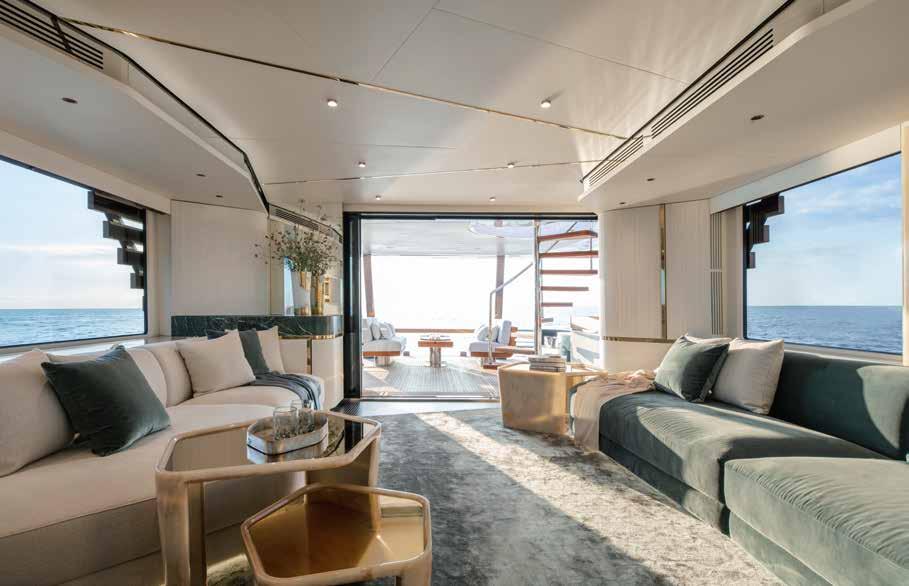
Above, the living area seen from the stern: Vincenzo De Cotiis has imbued fibreglass with new nobility as an innovative design element. Here it has been handcrafted (see coffee tables) in several layers and enhanced with bronze powder to yield parchment-coloured surfaces
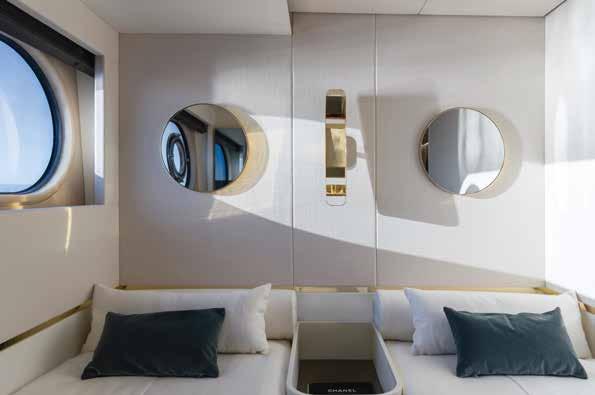
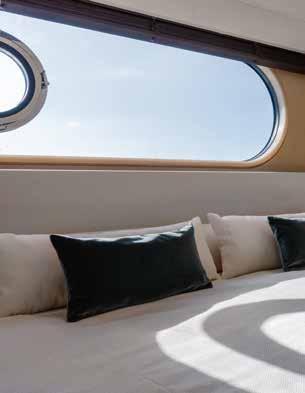
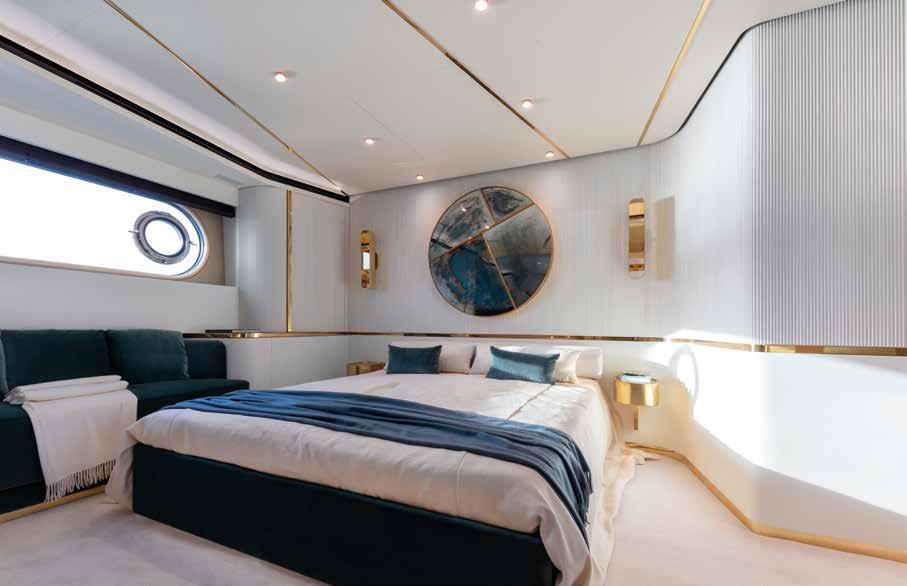
The styling strategies used on the main deck continue on the lower deck where there are four staterooms: two VIPs (below left), a double and a cabin with twin sliding beds (opposite page) as well as the master suite (above). Clever atmospheric optical effects abound, especially a cloud-like artistic effect
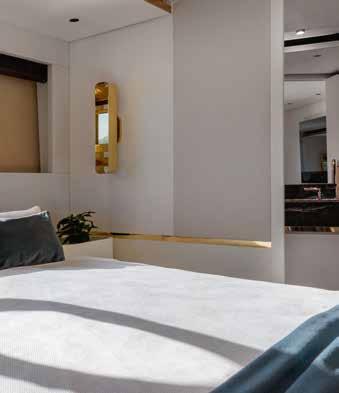
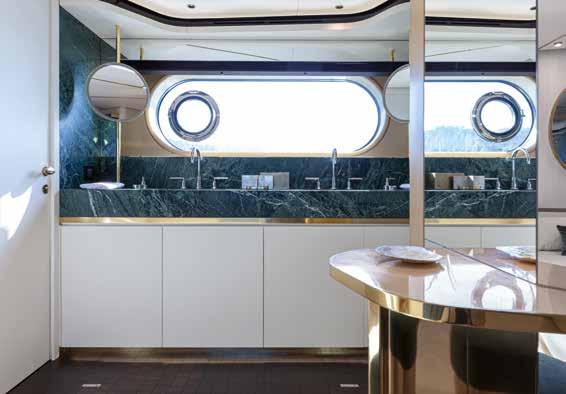

Exterior Design Ken Freivokh
The Magellano 25 Metri is a true ‘live aboard’ yacht that embraces the concept of slow, very comfortable cruising. It is designed to be used in all weathers, to explore new destinations, not only to go from A to B, but also to enjoy the journey! Its panoramic windows, generous headroom, wide, comfortable spaces and all the necessary facilities are designed to enjoy extended cruising with family. That is the real ‘raison d’être’ of the Magellano range, and the 25 Metri was designed fully in line with that purpose. The glazed superstructure is evidence of its panoramic windows and the fact that you can enjoy sea and sky views from most areas of the yacht. The essential characteristics are very careful attention to detail, correct proportions, open plan spaces. Details such as the wood louvres at the end of the panoramic windows provide a considered conclusion to the glazed surfaces, introducing the open and very comfortable cockpit. Frameless windows, purity of line and evident overall sense of purpose add to the yacht’s personality too. The palette of materials, colours and details are all indicative of its timeless design. The hull is as purposeful as the superstructure – it is a semi-displacement hull, which makes it extremely versatile, and able to navigate by piercing the waves and choppy sea at comfortable displacement speeds. The De Cotiis design reinforces the concept of a truly open interior, with long sightlines, continuity of surfaces and honest expression of materials. The result is a timeless, purposeful and elegant yacht to be owned by seafaring customers who love beauty and the sea. With generous, well-ventilated internal spaces and really handsome external guest areas at the flybridge, foredeck and aft cockpit, inviting guests to spend most of their time outside. The Magellano is thus a place people will choose to be and that is no mean feat in these pandemic times.
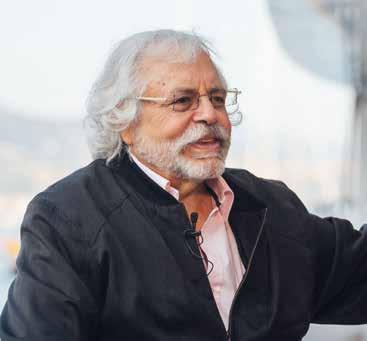
The Magellano 25 Metri also has a strikingly unusual design created by nautical genius Ken Freivokh’s sublimely timeless lines. The entirely glazed superstructure was a central element of the design and creates the ambience of a seafaring penthouse. This is the perfect yacht not just for cruising but also caters to the current trend of bringing man and nature closer together, thanks in great part to a transom that opens out to the sea


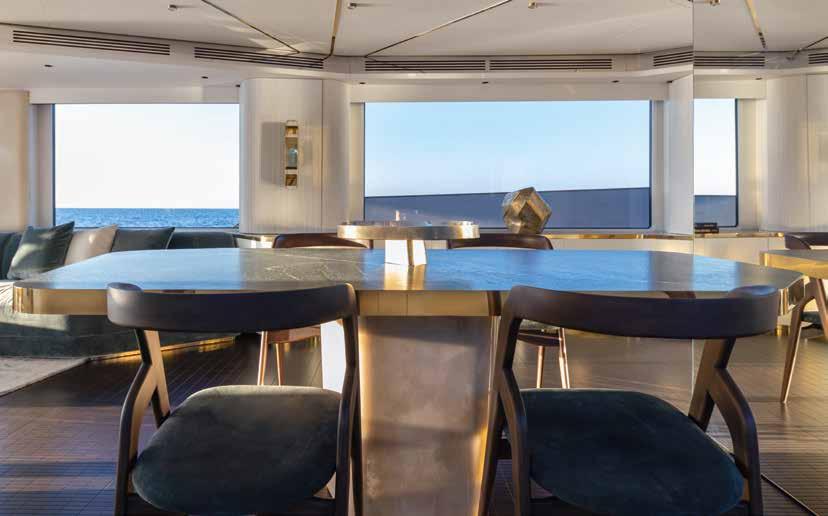

Interior Design Vincenzo De Cotiis
When I saw the boat I realised that it might be a project that would inspire me and also allow me to pour my experience into the interior. We dealt with the problems that arose with the Azimut Yachts technicians, first and foremost being the limited spaces. This is why I focused on perspectives, making the spaces seem bigger by using interplays of mirrors and light, whilst also retaining the yacht’s power and form. We began with the concept of a wave. Starting with the colour teal blue, which is reminiscent of deep sea, we used a lot of wood and white, typical of yachting, as well as elements that referenced the movement of the sea. Light plays a fundamental role in creating the particular atmosphere I am talking about: specifically natural light which is used to the maximum thanks to the boat’s large apertures but also thanks to great depth of perspective. Furthermore, my work, which is very close to contemporary art and design, is essentially synesthetic. I love an approach that stimulates all the senses: sight is the first, but oftentimes the interpretation of the work involves touch and sound too. That’s why I chose materials that create powerful, new tactile sensations. The materials and woods used include: brushed Verde Alpi marble, dark walnut, polished brass, lacquered and ribbed wood. That also meant leaving imperfections in the details so that they retain their natural quality. I don’t want to remove the signs of time because I feel that they can enrich the end result, giving them new energy and a new meaning. So I go looking for imperfection which I then tend to highlight. I use a lot of fibreglass in my artwork. It is a basic component in yacht building too, which I have elevated and turned into a design element, pairing it with more luxe materials. I wanted to add some pieces, such as the chairs, the occasional tables in the lounge and the large table in the main saloon. That said, I do tend to keep my twin souls – the artist and the architect – quite separate. In this project, the design side came more to the fore. The most significant area, which is also my favourite, is the main saloon because it best represents that striving for depth. We tried not to impose physical limits and barriers on the gaze to allow it wander all the way to the bow. The space feels like it is expanded, thanks to a flowing design that references that idea of the wave, the movement of the sea also translated into the interiors to emphasise man’s relationship with the surrounding environment.
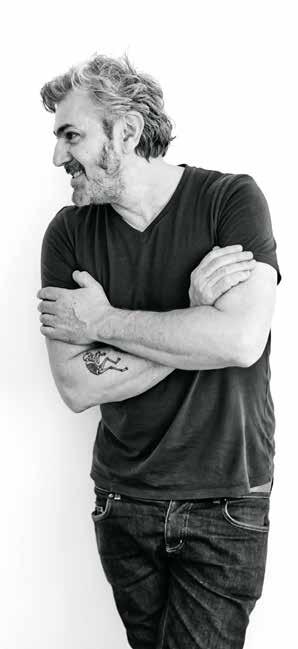

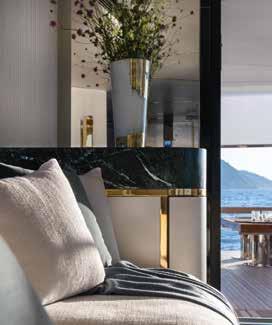
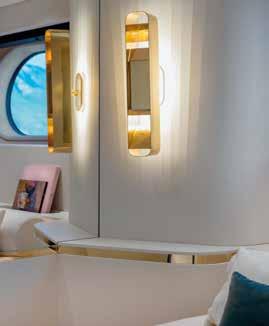
Every single piece of furniture aboard was bespoke-designed by Vincenzo De Cotiies and has an organic feel and shape. The Magellano 25 Metri’s furniture and décor feature striking combinations of fibreglass for surfaces and furniture with wood and other materials including brushed green Verde Alpi , dark walnut, carpeting, polished brass, lacquered wood and grooved wood to produce attractive and original contrasts
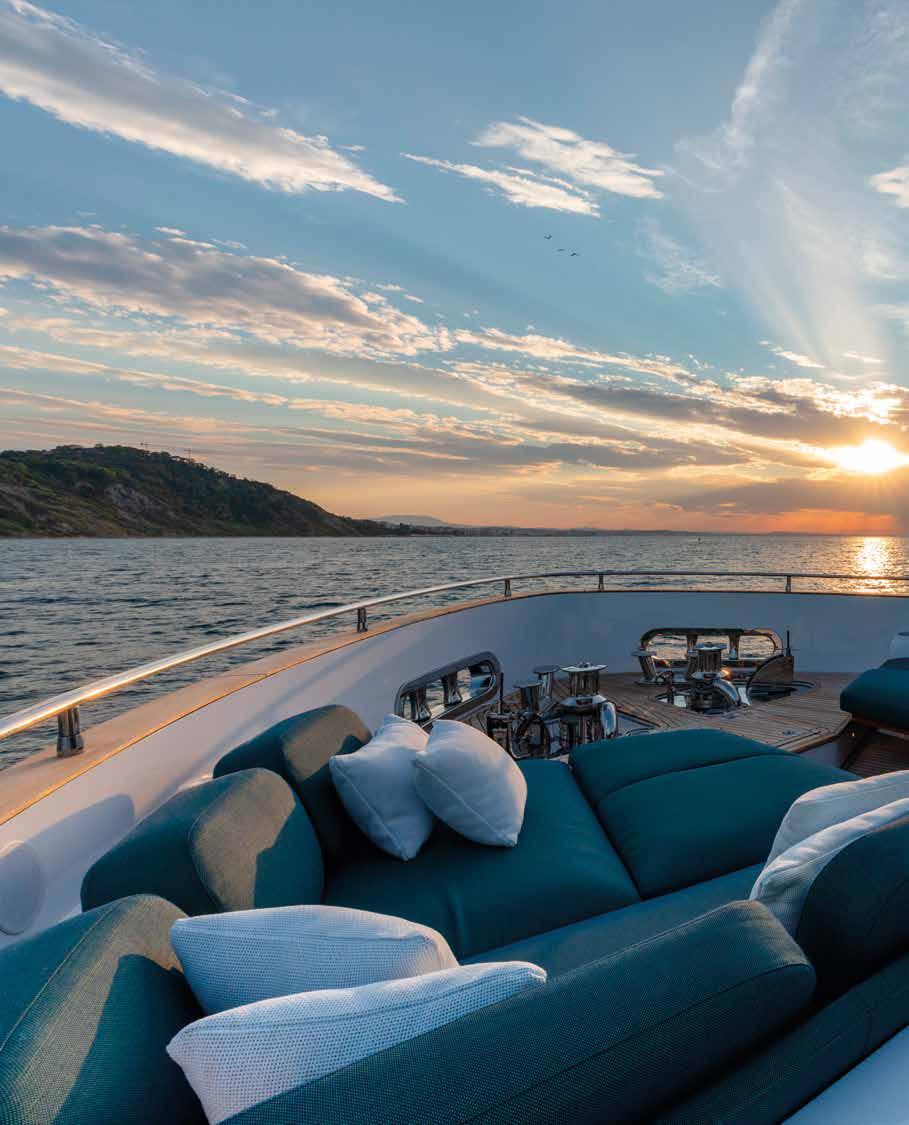
The Magellano 25 Metri is a semidisplacement yacht with enormous windows that offers absolutely incomparable pleasure for owners who love being at sea. It is also wonderfully silent and reliable as befits a craft designed for extended cruising
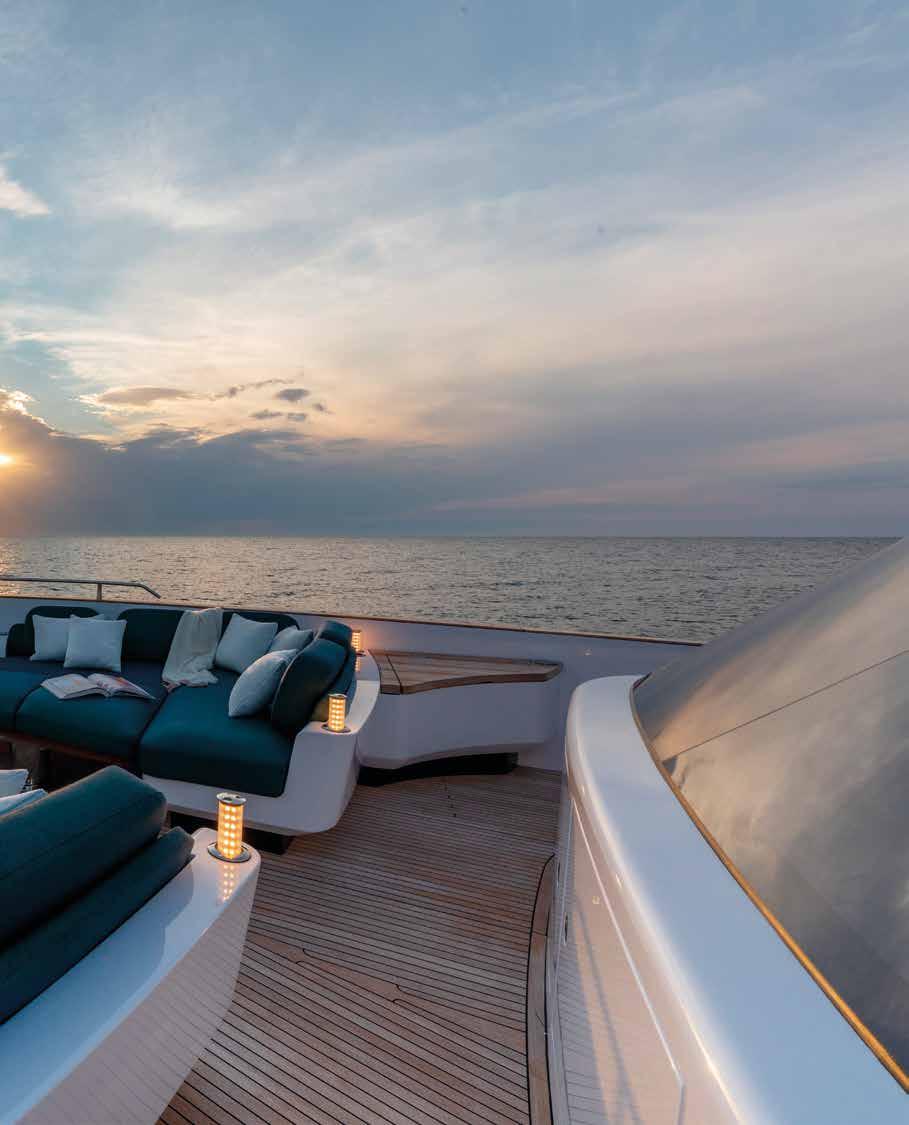

Right, the lounge area on the fly is another al fresco spot where guests can luxuriate in the joy of being underway. Power comes thanks to a pair of 1,400 hp Man engines (1,500 hp units as optionals)
The Shipyard Giovanna Vitelli Vice President Azimut Yachts
The new 25 Metri was designed to inject new life into the Magellano Collection which has always epitomised a particular type of displacement yacht characterised by generous spaces with large windows and designed for owners who love a completely silent, utterly comfortable navigation experience. The project allowed us to successfully combine the more technical spirit of the boat, which normally doesn’t have a great aesthetic appeal, with sophisticated, contemporary forms and décor, so that we could offer the market a very original boat. As a great Magellano connoisseur and navigator, Ken Freivokh brought new freshness to the classic exterior lines, while Vincenzo De Cotiis added in his particular brand of timeless elegance by using fibreglass in an unusual way and also organising the spaces in an original manner. Stepping aboard the Magellano 25 Metri is like immersing yourself in beauty and I am very satisfied with the aesthetic and functional harmony it exudes. This model experienced a huge media success because it was supported by several special initiatives, such as a short film by Gabriele Muccino and an event in Portofino. So even before its official launch, it attracted a lot of attention and surprising consensus with sales following as a result. Furthermore we are already working on the Magellano 30 Metri, this yacht’s larger sister, which is the product of an equally exciting project that most certainly won’t go unnoticed. We expect the Magellano Collection to continue to gain consensus by attracting an evolved but not rare kind of owner for whom the journey is a fundamental part of the travel experience. The type of owner that appreciates the pleasure of beautiful seascape and the taste of time spent in good company and in absolute comfort and complete relaxation. This very unusual time in history has also definitely increased people’s desire for safe holidays in close contact with nature with their families or a tight circle of people. This is what I did last summer aboard the 25 Metri and I was really wowed by life aboard: it was a real journey within a journey.”
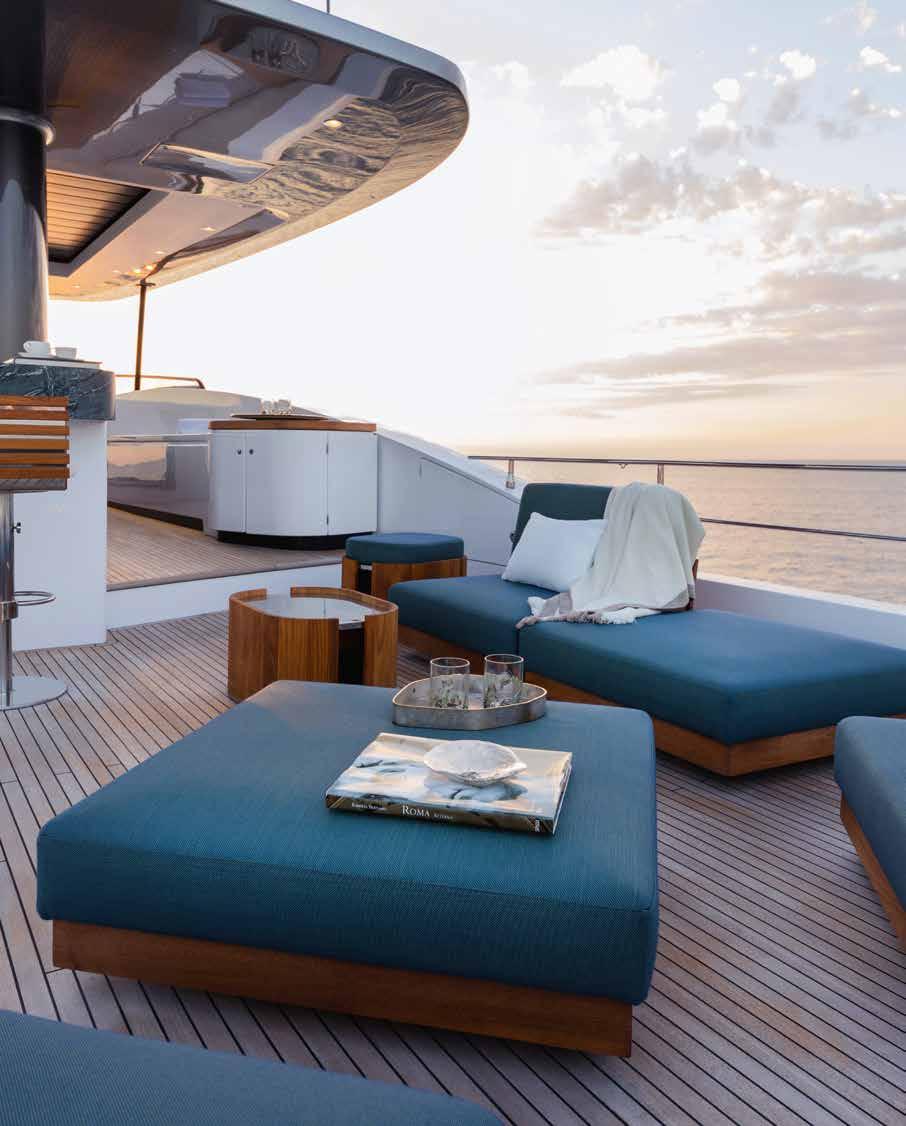
THE OTHER SIDE OF EXCLUSIVITY
The new wave of interior decoration on board large yachts is making more and more frequent use of works of art, like the marble sculptures by architect Enrico Gobbi of Team for Design studio
by Micaela Zucconi
The Warrior, Black Marquinia marble. A complex sculpture of a man’s head, grooved all over. The artist fluted the marble head to represent life’s difficulties
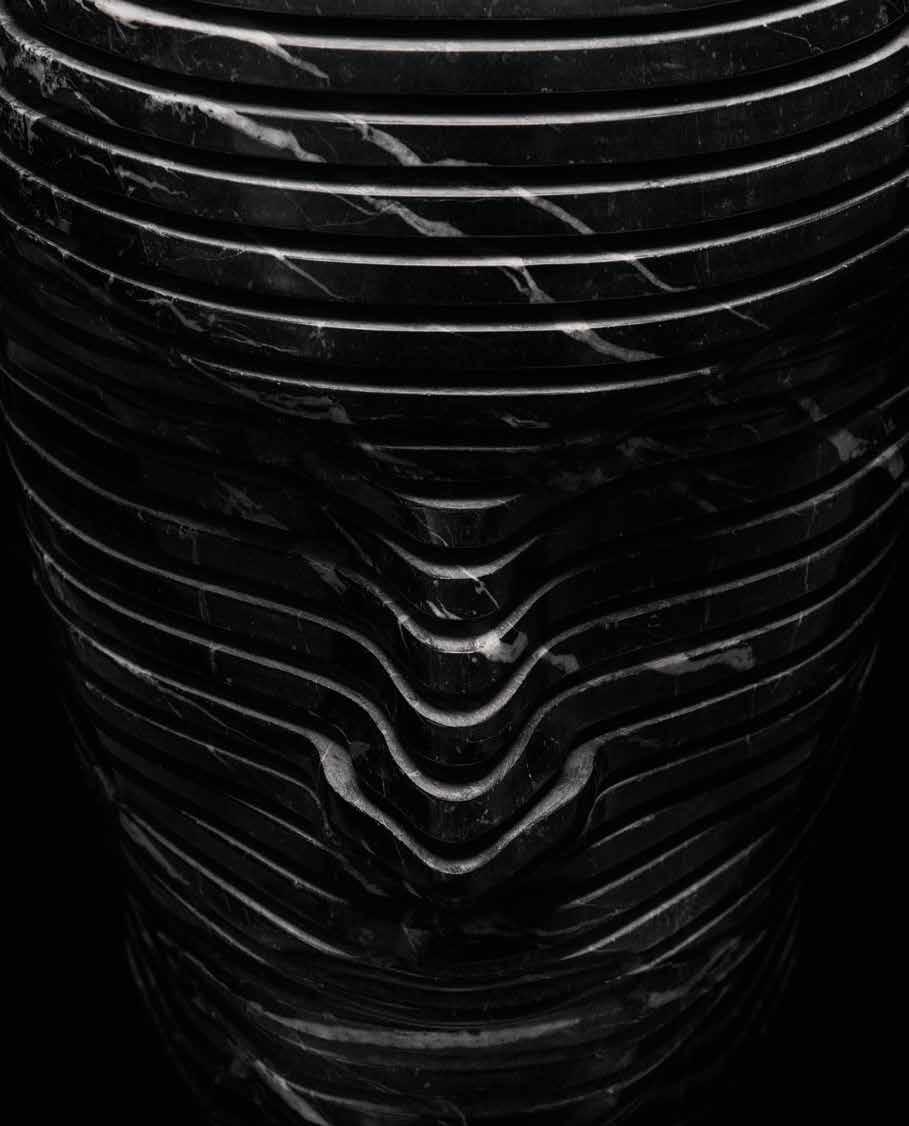
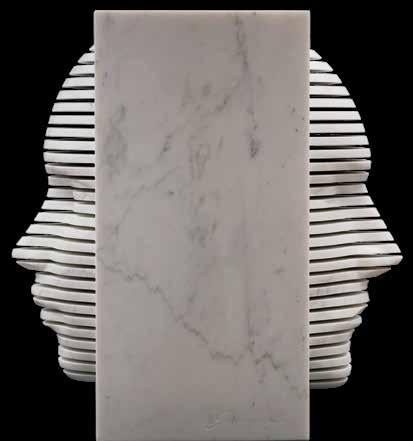
Above, He She, Bianco Carrara marble, representing the couple. Both faces look outwards almost to protect the priceless fortune they hold. Right, the architect and artist Enrico Gobbi, the creator of the sculpture and owner of the Team for Design studio in Venice
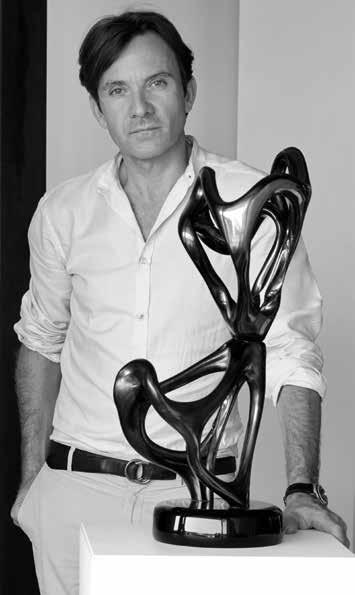
Current trends in the world of boat and yacht interiors increasingly emphasise personalised solutions. Design and art are playing an important role in these developments, especially in the context of large yachts, floating villas that must be comfortable and aesthetically pleasing as well as functional. One expert in the sector is architect and designer Enrico Gobbi, born in 1974. A true Venetian, he has the sea in his veins, a nautical awareness refined by following a postgraduate specialisation in the USA to complement his familiarity with the architecture of La Serenissima. The magnificent marbles of his native city are a further source of inspiration that adds a little extra touch to his projects, also influenced by the lessons of great modern architects like Ludwig Mies van der Rohe and the members of the Bauhaus school. “For some years now in the final stages of our projects we’ve become increasingly involved in the selection of the artistic works that round out the furnishing concept. Drawing on my old passion I began to design sculptures for our clients’ exclusive use. This collection now comprises five sculptures, each in a series of 10/12 numbered pieces, but in fact all are different because they’re handmade by experienced artisans”, says Gobbi. The first in the series was “The Warrior”, a male head that in some ways “Looks to the past, evoking the portraits of the Roman age but given a modern interpretation. The cuts refer to the ups and downs of life”. This work was followed by “He She” – a sort of Janus with a masculine and feminine face symbolising the couple and the precious value of love – and others with a more abstract form, with more of an architectural influence. “Twisting Thought” shows the
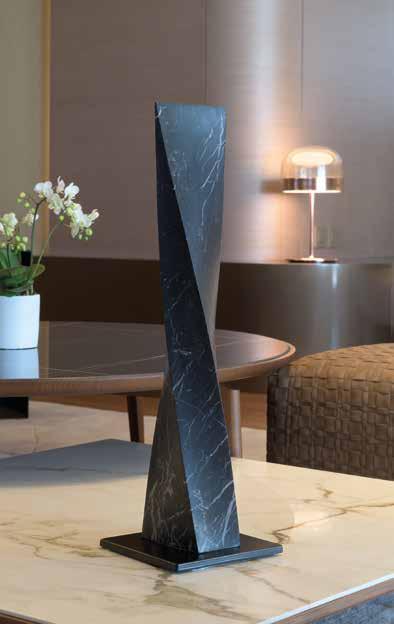
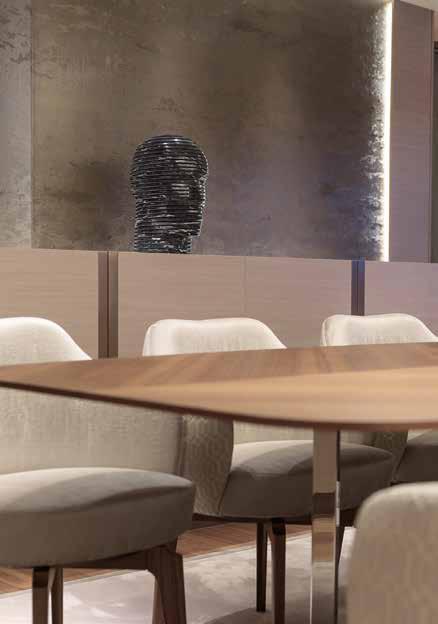
perfect torsion of a geometric solid recalling a Dubai skyscraper, intended to represent the human mind and its complex thought processes. With its twisting forms, this piece was very difficult to achieve in marble. The reference to the emotions, the feelings that unite two people, returns in “The Lovers”, a celebration of the power of love through a harmonious, essential form. “The pieces are made by Decormarmi in the province of Vicenza, a company with a long history in working this material. The artisans rough-hew the block then work it by hand. Every sculpture is revisited in the final stage. It has to be perfect. When the marble is being sculpted it’s exciting to discover the different veining that makes each piece unique”. Calacatta and Carrara marbles are the preferred materials, which the architect’s Team for Design studio also uses for interior projects. “Art was already present on large yachts, and owner Aristotle Onassis was a pioneer. The furnishings resemble those of a land-based villa. My team and I work on no more than five or six projects a year and we’re specialising in one-off pieces involving the skills of a number of top-class artisans. It’s art on art”, says Gobbi. The sculptures in his collection will be seen on board almost all yachts, standing in important locations, not simply decorative objects. Some are on display in the Rossinavi office/ showroom in Viareggio, where most of these luxury vessels are built. As a good Venetian, the artist’s next project is to transpose some of these projects into glass, taking advantage of the experience offered by several master glassmakers and an important gallery on Murano that he has collaborated with before.
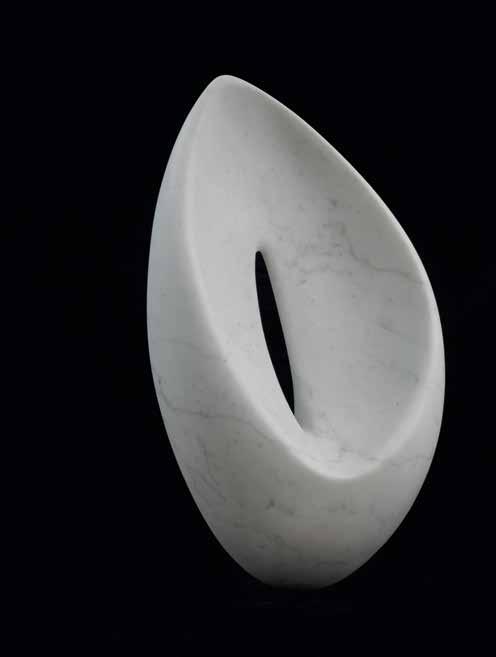
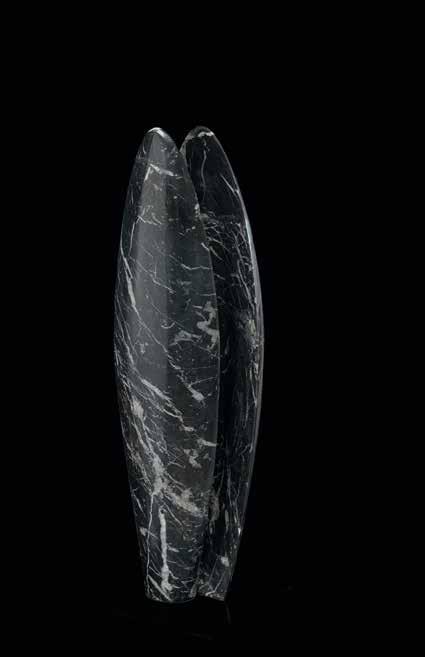
This page, top left, Calla, Calacatta marble. The artist was inspired by this charming flower to create a sinuous sculpture that embodies a sense of purity and candour. Right, The Lovers, Black Marquinia marble, an abstract sculpture representing two petals standing close together, symbol of the strength of love between two people. To side, Abbraccio, Bianco Carrara marble. Left-hand page, Twisting Thought, Black Marquinia marble. In the dining room, The Warrior

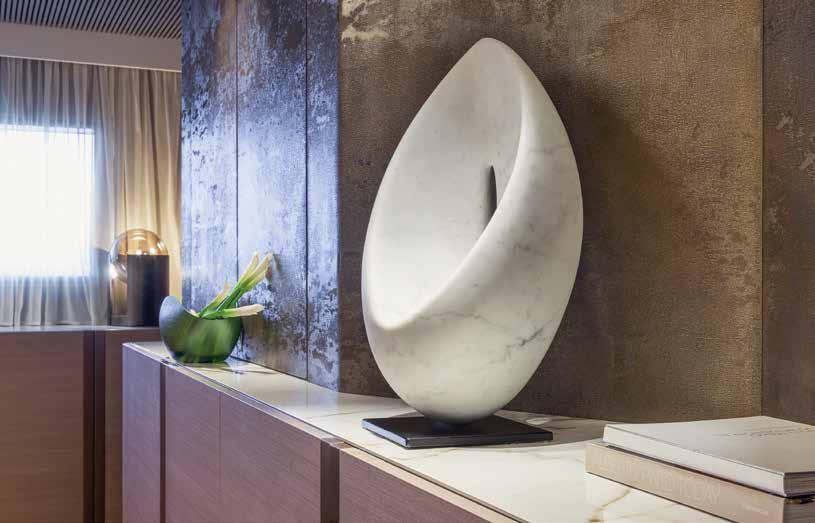
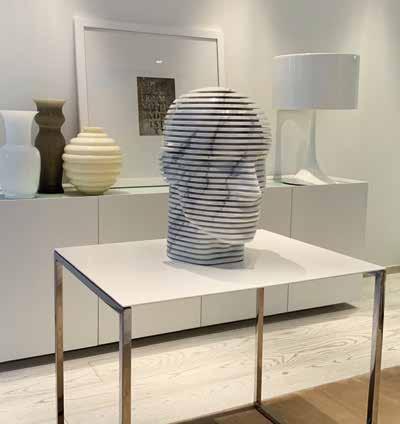
These images: three pieces designed by Enrico Gobbi and made by Decormarmi, a company with a long history of working in this material


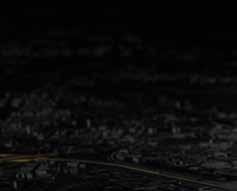




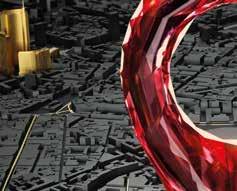







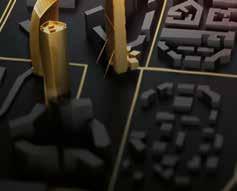

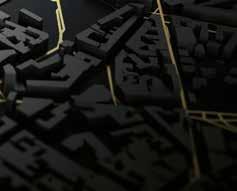



Style without Limits
From the codes of classic elegance to an eclectic, informal inspiration. Limitless creative freedom for a brand that from the moment of its launch has captivated us with new forms of expression
by Marta Bernasconi
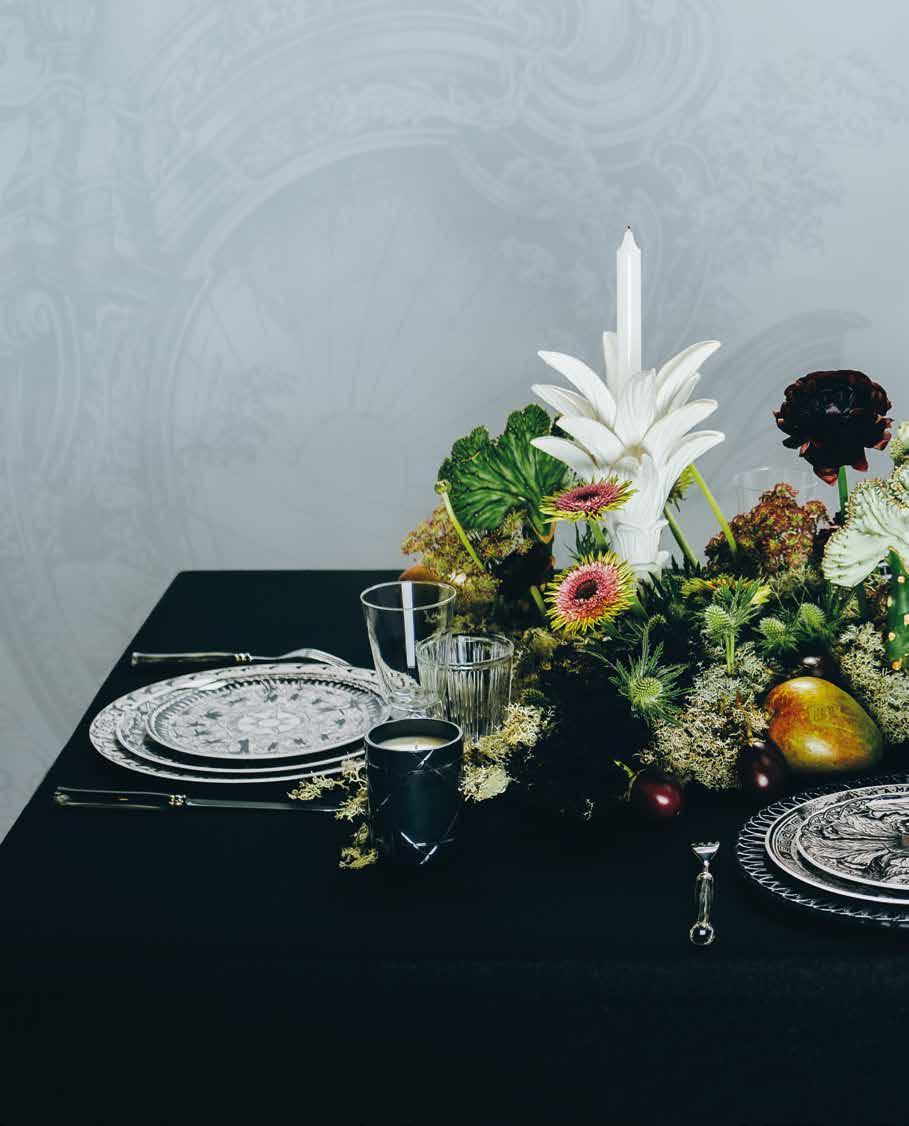
30 Avenue Montaigne is the legendary Paris address of the first Christian Dior boutique ( 1947). In 2019 the Dior Maison boutique opened at number 28 on the same street, and here the great creative talent’s imagination interprets the art of living. The table lines include the Constellation collection, with black and white decorative motifs
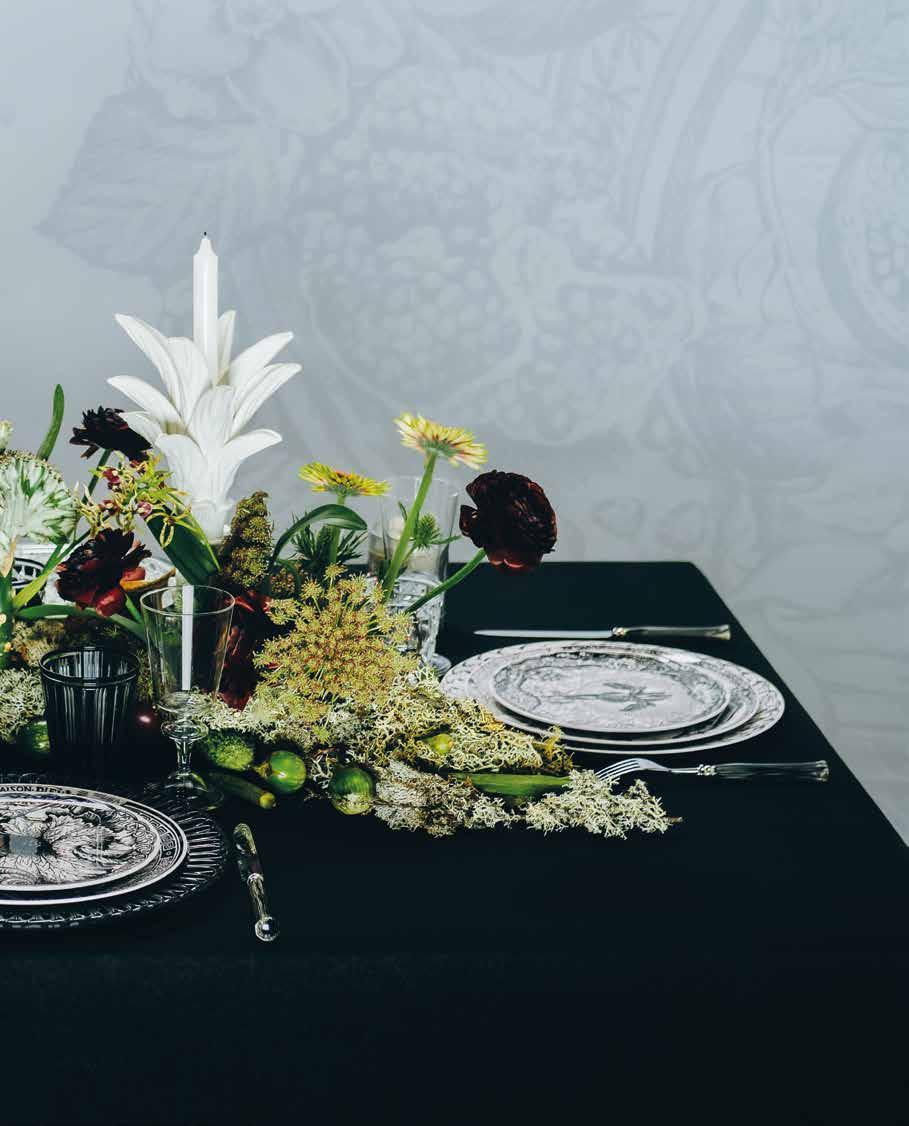

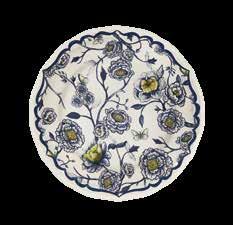

is creations immediately became objects of desire. He first began to cast his spell in 1946, the year the Parisian fashion house was founded. Christian Dior had a unique ability to highlight femininity in its most attractive and exciting form, introducing new, often revolutionary ideas in every collection. He was also responsible for creating the New Look, complementing the lines of his garments with accessories, shoes, bags, scarves, perfumes and gifts. Genius, insight and daring experimentation led to the creation of an exceptional heritage that now also includes furnishing complements and the art of hospitality. In fact, even in the early days of his stores it was possible to find vases, mirrors and crystal glassware alongside the Dior clothing. The home collection grew, nurtured by a long series of collaborations with artists and experts who scoured the world for original, skilfully-produced pieces. In 2016 the brand launched limited editions by artists and designers such as Lucie de la Falaise, India Mahdavi and the architect Peter Marino. The Dior Maison boutique was opened in Paris in 2019. The table collection featured pieces taking up the symbols of the Dior code like the “cannage” motif, gingko leaves and the iconic toile de Jouy design, now populated with wildlife. From its beginnings to the present day, CD’s dining and home line has rested on a threefold base of colours, design and style, all inspired by a search for quality and sophisticated manufacture and all deeply rooted in the brand’s DNA. A link with the passions of the great French couturier remains a further distinctive element in many collections. This clear in Constellation, the series created by the brand’s creative director, Maria Grazia Chiuri, and artist Pietro Ruffo to reflect Christian Dior’s interest in astrology. The result is black and white illustrations that add a new impact to the appeal of traditional Tarot cards, appearing on Limoges porcelain plates and trays. Fortunately the French stylist had a wide range of interests, and these still provide an eclectic source of inspiration in the creation of table and home lines. All of these styles, though, express a personal feeling, showing the truth of Dior’s words when he said, “Living in a house that doesn’t look like you is a bit like wearing someone else’s clothes”. www.dior.com
The Italian hand-blown glasses are given movement and life by exuberant multicoloured writing on a transparent background. Above, Granville, a collection designed by Cordelia de Castellane celebrating Christian Dior’s passion for the flowers that grew at the family home in Normandy
The traditional Tarot images inspire the Constellation line. Christian Dior loved the Tarot, revealing his superstitious nature. The stars were among his favourite symbols, also reproduced on embroidered cushions
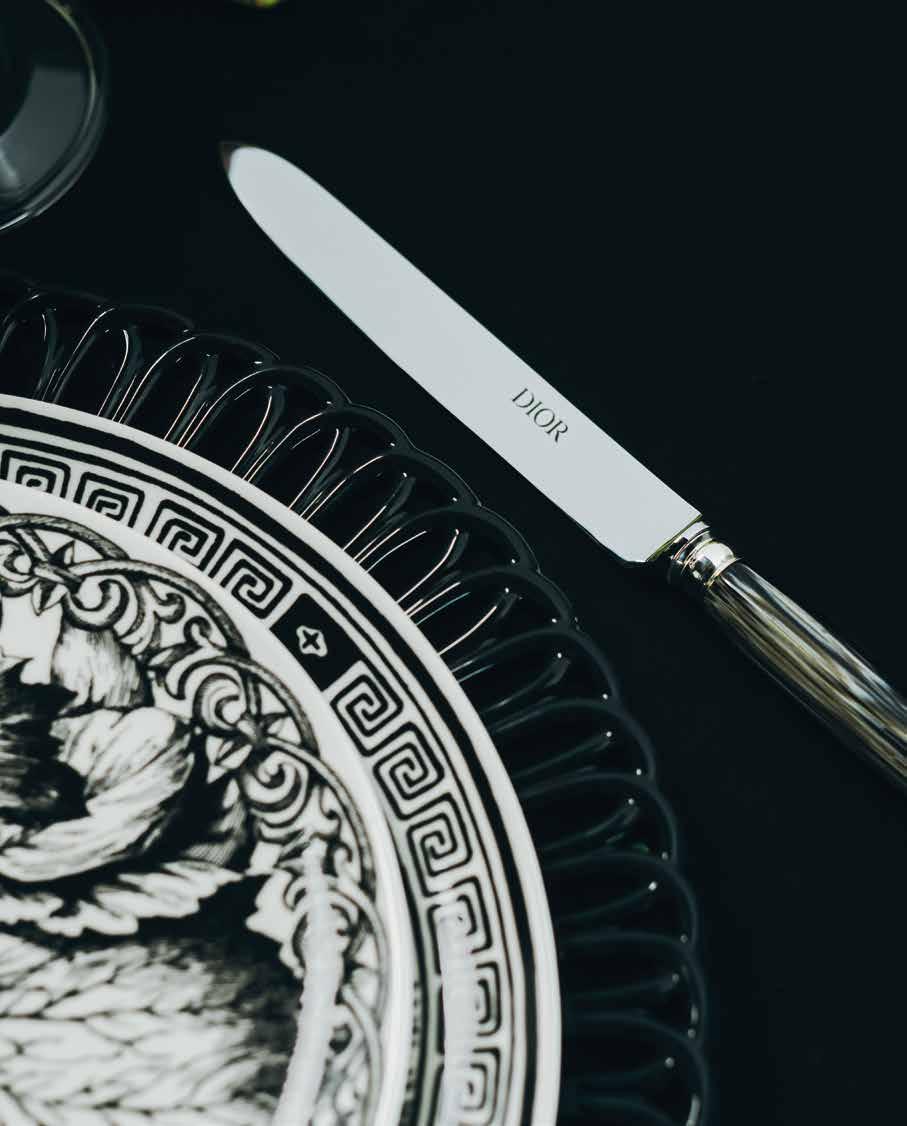
The beauty of lines reflecting maritime tradition and an essential style creates a sophisticated, relaxing mood. A custom yacht that’s an unmistakable Codecasa design
by Paola Bertelli - ph. 3dSign Studio
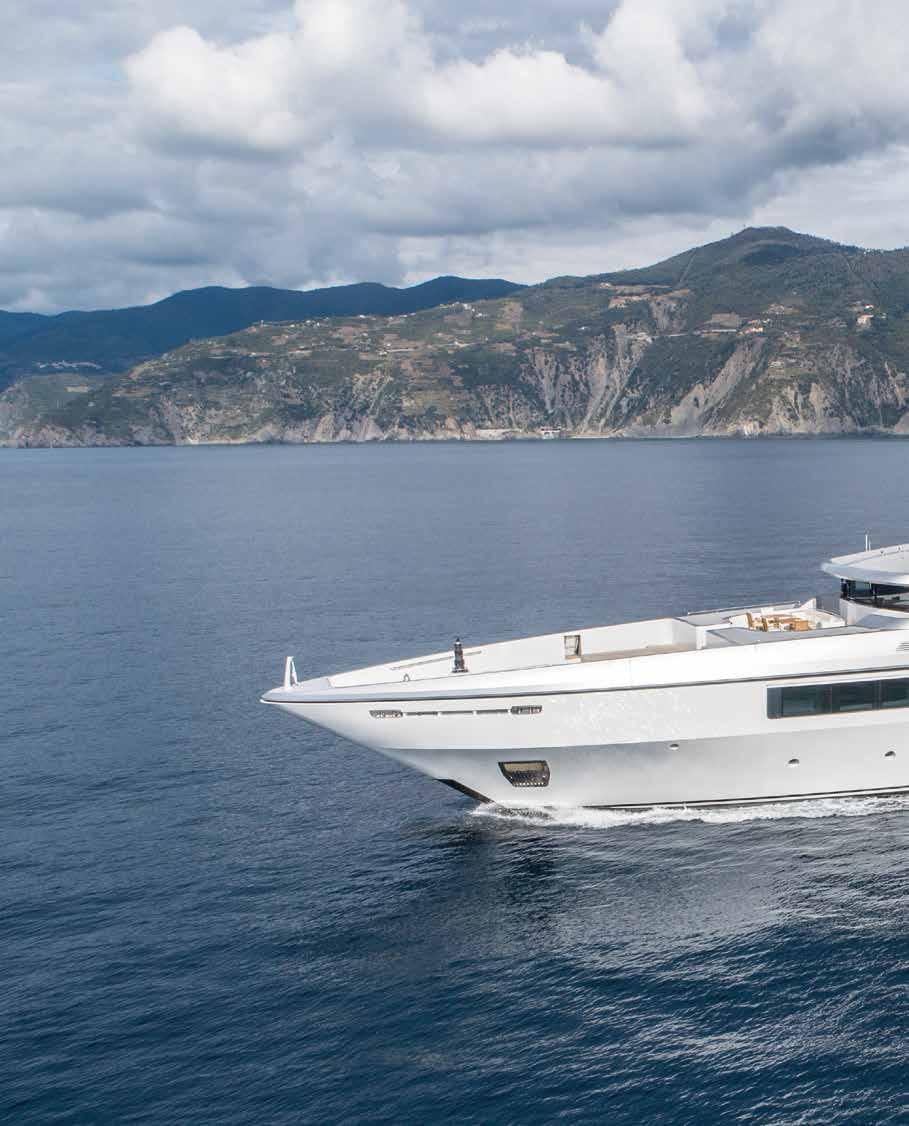

he owner of the new 55-metre Framura, launched in July 2020, is one of Codecasa’s repeat clients. The new yacht, five metres longer than her predecessor and much more spacious at 720 GT compared to the older version’s 498 GT, is a steel and aluminium four-deck vessel built to the yard’s own design with interiors that are the result of a collaboration between the owner’s architect and Codecasa’s style office. The white and silver livery emphasises the essential geometry unfolding through the horizontal lines of the decks that together with the tapered bow accentuates the yacht’s natural dynamism. The shapes reflect a respect for maritime tradition that fits perfectly into a modern setting. The yacht’s general concept is based on a search for sober elegance with a constant emphasis on functionality and details. The decorative elements are never there simply for their own sake. The interior spaces are enhanced by the large windows and linear furnishings. With a subtle play of light and shade, the light, natural colours harmonise to create a peaceful, relaxing atmosphere, refined yet informal. There is a rich selection of materials - from classic teak with a natural finish for the floor staves of the guest areas and in a herringbone pattern in the lobby - to matt white lacquered wood for the furniture and ceilings, aged brass handrails and coffee table legs and leather bedheads. Various types of marble also feature in the bathrooms, with gold vein Bianco Lasa for guests, pink onyx for the VIP cabin and precious lapis lazuli for the inserts and decorations in the owner’s bathroom. The furnishings are in part bespoke, in part designer products and in part created by the yard’s style office. The result is a pleasing consistency throughout the entire yacht, with cabinets, bedside tables and desks in white wood. whose special teak tops have an inclined section in the corners to enhance and enrich the design, as well as teak consoles, extraclear glass and aged bronze. The lounge sofas preceding the dining area are made to measure by the Milanese upholsterer Paola Stabile, while the dining area has an oval table designed by the owner’s chosen architect, with a clear glass top and teak and brass circular bases. The Magda chairs in quilted white leather are by Calligaris. The aft partition that delineates the space creates an ingenious play of light effects with alternately-angled wooden slats and flush mounted LED dimmer spots. Further forward, the VIP cabin precedes the full-beam owner’s suite with study and lounge. A further four guest cabins can be found on the lower deck. Besides a spacious TV area the bridge deck lounge also boasts a conversation area with Minotti revolving chairs and a games corner with table. The design of the helm station by Team Italia is a modern interpretation of the observation point concept embodied by the bridge on classic vessels. The walk-around central isle and the two lateral extensions behind the windows provide total control in all operational scenarios. The sun deck is a haven of relaxation. In the centre a gym is accessed through two sliding doors, while further forward lies the sunbathing area and aft there is a lounge with bar space. White dominates the exteriors, too, complemented by an abundant use of teak. This wood is also used for the floors and many of the pieces made to measure by local artisans, like the armchairs, sofas and coffee tables in the aft cockpit, or the director’s chairs, the rectangular table on the bridge deck and the square tables on the Portuguese deck, an intensely private terrace with a breathtaking view of the sea. www.codecasayachts.com
The conversation area with sun loungers on the sun deck. The relaxation deck, with gym accessible through two sliding doors. Opening, the Framura has a steel hull aluminium superstructure. A displacement yacht, she has a range of over 5,000 miles at her cruising speed of 12 knots

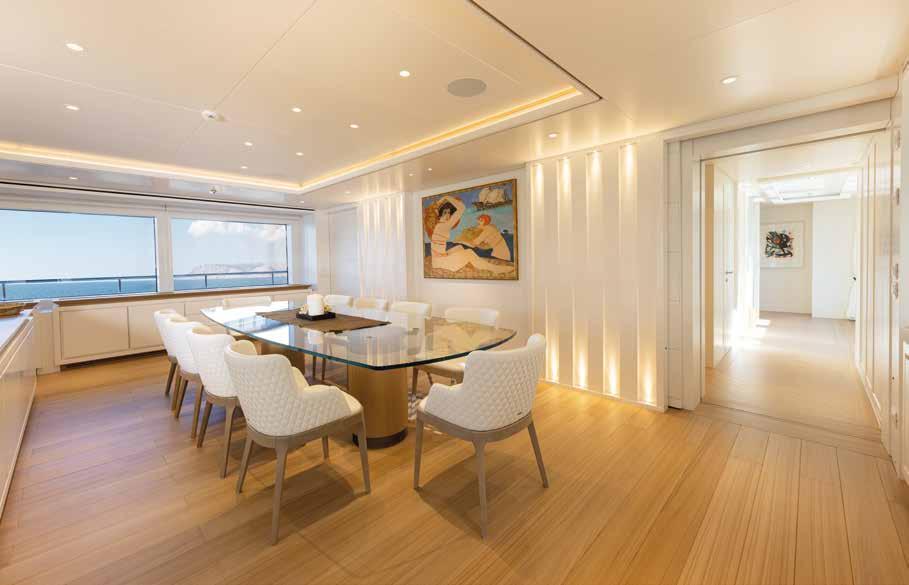
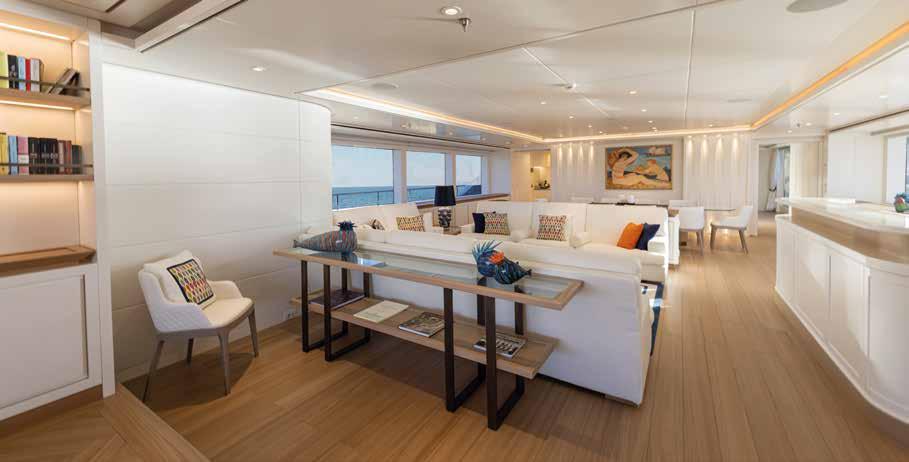
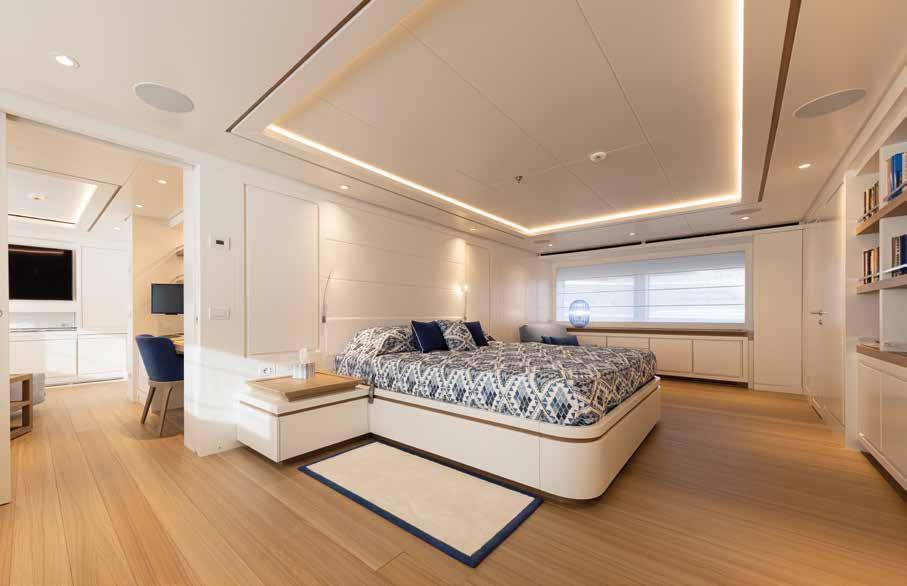
White and the warm colours of teak dominate in the interiors, characterised by a sophisticated uniformity. The owner’s suite (top) and VIP cabin (right) are on the main deck, as is the lounge (opposite page). The bulkhead is the background for the painting l’Approdo di Ulisse by Salvatore Fiume, and is enhanced by a play of light created by alternatelyangled slats, the dining table is built to design with clear glass top and circular bases in teak and brass, the chairs are by Minotti

Exterior Design Domenico Gozzani, Codecasa Technical Office
The owner had already had a fast, high-performance 50-metre Codecasa open, but during his long, happy experience with this model he developed new requirements. When he came to us with his new specifications, we suggested a displacement yacht with greater autonomy and a good cruising speed. All this would provide a greater on-board comfort with more space and volume available both for him, so he could work remotely in his personal study in the owner’s suite, and for the members of his numerous family. As a result, while the engineering section focussed on designing a new hull that would fulfil the owner’s specifications, the architectural office developed an interior layout to suit his needs. The client, a level-headed, refined and discerning individual, also said that from the point of view of interior design he wanted the yacht to have a sober, solid, elegant yet sporty look that also reflected a decisive, sturdy and coherent character in line with his tastes. It should all be simple, extremely linear and contemporary. This brief led to the C123 project, now the MY Framura, and when it was presented to him his immediate reaction was one of great enthusiasm. It was a pleasure to see that the new Codecasa build’s profile met his requirements exactly. The 123 project is a natural evolution of the Codecasa family feeling and its livery accentuates its sporty character and sober elegance.
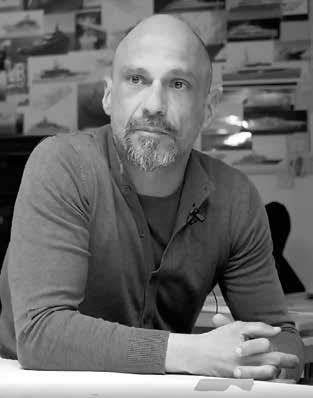
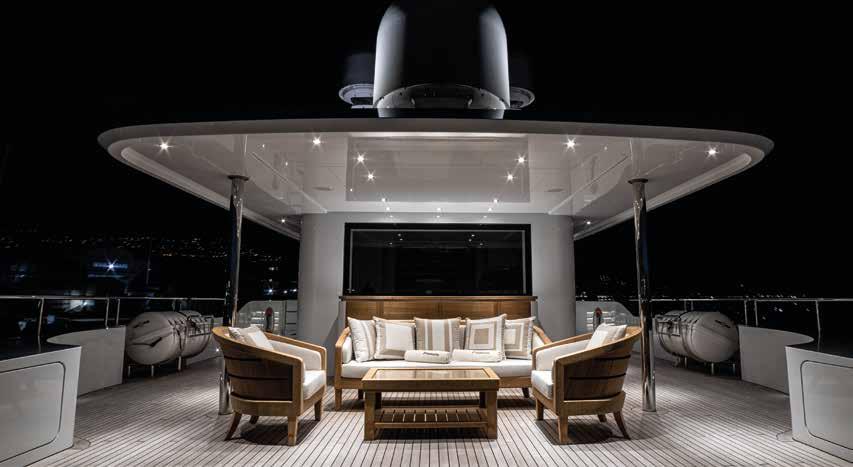
With a design that reflects nautical tradition, Framura displays the elegant sobriety of her clean, rigorous lines. The exterior lounges are furnished with free-standing elements made in teak by local artisans

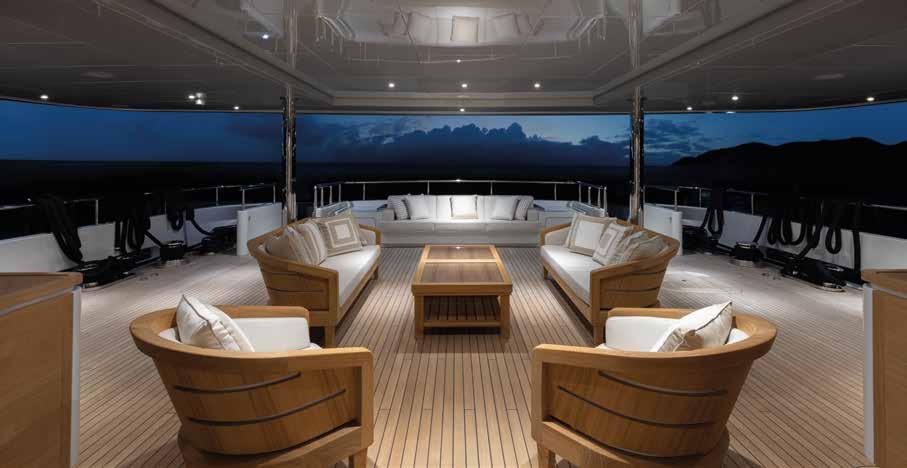

A rug with a geometric pattern defines the bridge deck conversation area (above), the two revolving chairs are by Minotti, the coffee table in extra-clear glass with aged brass legs is designer-made. Below, one of the lower deck guest cabins and opposite page, bottom, the aft cockpit it’s a welcoming al fresco lounge which recreate the same simplicity and comfort of the interiors
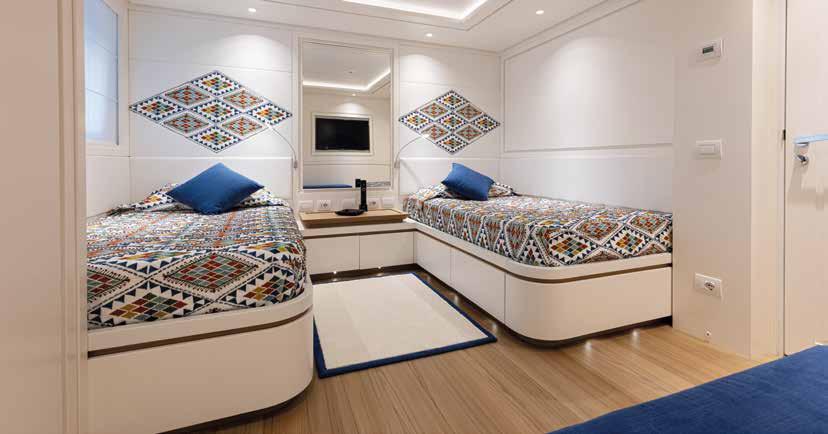
Interior Design Sara Mencacci, Codecasa Style Office
The owner asked us to create simple, functional spaces with a decisive feel, using materials with a natural appeal. In collaboration with his architect, a person we’ve known for years, we developed an efficient design emphasising simplicity and comfort. Our aim was to give guests boarding the yacht a feeling of tranquillity and general well-being generated by large, well thought-out spaces flooded by natural light entering through large windows. All this would be surrounded by the sound of the waves and its wonderful colours. On his previous yachts the owner chose the darkest woods like wenge for the floors and bleached oak for furniture and walls, but on Framura he decided to lighten the surroundings. Before selecting materials and colours we showed him the interiors on board yachts from our Vintage series. He drew inspiration from these and specified that he wanted the new Framura to be dominated by light colours. Most of the furnishings are made to design, we wanted to create a sense of coherence on board and once the details of the furnishings, drop ceilings, tops and the rhythm of the cabinetry had been decided on we readapted them in the various spaces. Artificial light is provided by spotlights as well as decorative ceiling lights in the cabins and salons. Many of the table lamps are by famous brands like FontaArte, Foscarini, PortaRomana and Flos. As regards the relationship with the exteriors, I think every yacht has its own spirit, and I believe it’s expressed through welcoming, classic, clean interiors, We sought to recreate these qualities in the exteriors, too.

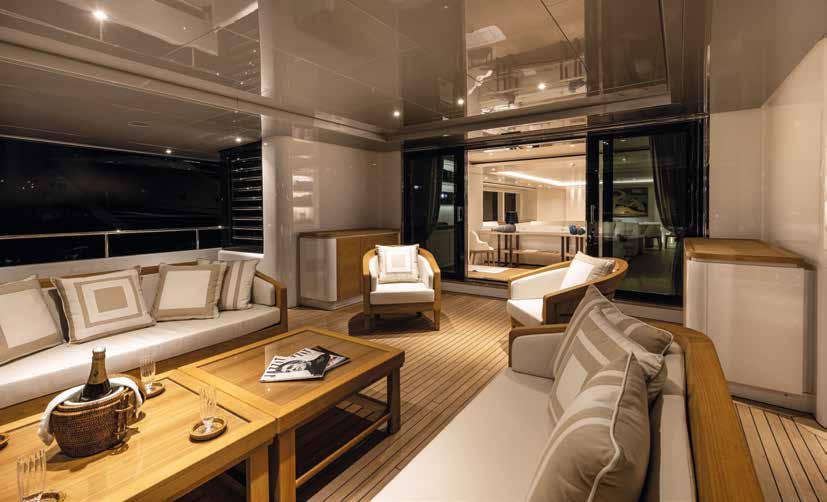
The Shipyard Fulvio Codecasa, Codecasa CEO
Like all Codecasa yachts, Framura is a custom build that reflects our family feeling. Our yachts are easily recognisable for their sober finesse and clean, rigorous lines. Framura has a clear-cut outline when viewed from the side, and the deck lines and windows run parallel with the water. She has traditional lines that I’d describe as rigorous and essential, sober yet refined. We’re sure that it’s a style that people will never grow tired of, and it’s a look that our brand is known for. As for construction technology, she carries cutting edge equipment that helps respect the environment by reducing consumption. An interesting solution featured for the first time in this build is the use of keel coolers to cool the emergency generator. We’ve installed latestgeneration systems that increase comfort and ensure maximum reliability and safety in a context of even greater environmental awareness. We’ve obtained outstanding results with Framura in terms of noise and structural vibration, comparable to craft with diesel-electric propulsion. The yacht boasts impressive fuel capacity and range – sailing at 12 knots, its 140,000 litres of fuel give the Framura a range of over 5,000 miles. It took us just thirty months to construct Framura, despite the difficulties caused by Covid-19. We have some large projects in the pipeline, with three yachts under construction – a 55, a 43 and a 58-metre. We’ve also presented a 24-metre concept, the Gentleman’s Yacht, an all-aluminium build in classic style inspired by yachts of the 1950s and 60s. This project was developed alongside Luca Dini Design & Architecture Studio, and we plan to build a limited run of ten in total. Then there’s a very daring concept, the Codecasa Jet 2020, a 70-metre yacht inspired by aircraft design. Despite all the difficulties, we’ll never be short of drive and confidence.


The lounge on the Portuguese deck, a space for those seeking to enjoy a spectacular view of the sea. Despite the problems caused by Covid-19, it took only thirty months to complete this 55-metre

WE THINK WITH EMPATHY
AND DESIGN WITH COURAGE
by Marta Bernasconi- ph. courtesy by Lazzarini Pickering Architetti
Claudio Lazzarini and Carl Pickering successfully explore different ar-eas of architecture and design. This fluid cross-fertilisation inspires a philosophy of transverse projects that overturn accepted ideas and revolutionise an industry where everything had previously seemed set in stone

Opening, a sketch of the new Benetti Motopanfilo, whose interiors and exteriors have been developed by the Lazzarini Pickering Architetti studio. Claudio Lazzarini and Carl Pickering (photo) identified some traditional elements of 1960s motoryachts and reinterpreted them, blending classic and contemporary into a new language

Afresh way of thinking that shuns preconceptions is the most striking aspect of the career path followed by Claudio Lazzarini and Carl Pickering. With a studio in Rome and completed projects throughout the world the architects handle designs in a range of contexts, based on a cross-fertilisation of ideas that prioritises an ability to listen. “Our main inspiration comes from our readiness to get to know the places where we find ourselves and the dynamics of the people who live there. We have a highly contextualised approach, and a secret that allows us to assess whether we’re doing a good job – we ask ourselves “Would we like to live here? Would we eat in this restaurant?” The residential buildings by the two architects display the main elements of their design language, which cross over into other areas like yachts. A perception of space is the underlying concept. “We think it’s very important to be able to perceive all the spaces visually. We place great emphasis on continuity and fluidity, and this translates into creating long perspectives that can be interrupted by systems of sliding or pivoting doors to create areas of privacy”. One example of this concept is the design for the villa The Bluff, a large, seamless space that includes study, lobby, kitchen in an extended visual sweep that can be divided into three sections with pivoting panels. This idea can also be seen on board yachts. The studio began working in this sector twenty-five years with a design for the interiors of 80’ sail yacht Wally B. “We liked race yachts, empty, where you could see the hull, which from an architectural point of view offers the most exciting surfaces. As a result we emptied the interiors and affixed containers that followed the sides”. On the yacht this idea of spatial fluidity inspires revolutionary solutions that culminate in eliminating the partitions between bathroom and cabin – the bathroom in the glass cube on Benetti Sai Ram marked a turning point and has frequently been copied. The dialogue between interior and exterior is another central theme in LPA’s work and is clear to see in their residential work – homes immersed in their natural surroundings and the paradigmatic design of Villa in the Chilterns, in the English countryside, where large windows create a spatial continuum and a skilful management of light. “When discussing light in an architectural project the subject is usually artificial light, but for us a natural light is just as important.
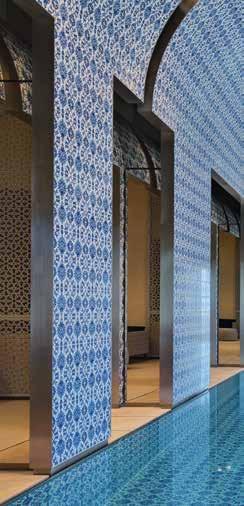

From top, the long perspective and extensive windows of the Villa in the Chilterns (UK) are distinctive elements in the LPA’s work, like the dialogue between interior and exterior that can be seen in the Sense Hotel, Sofia. The Al Bustan spa in Beirut shows the link with the cultural context of the locality
© MATTEO PIAZZA
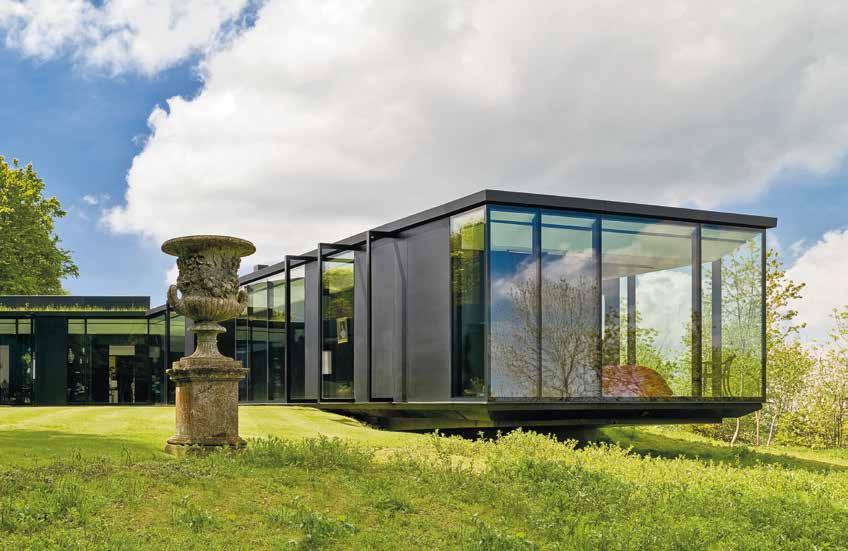
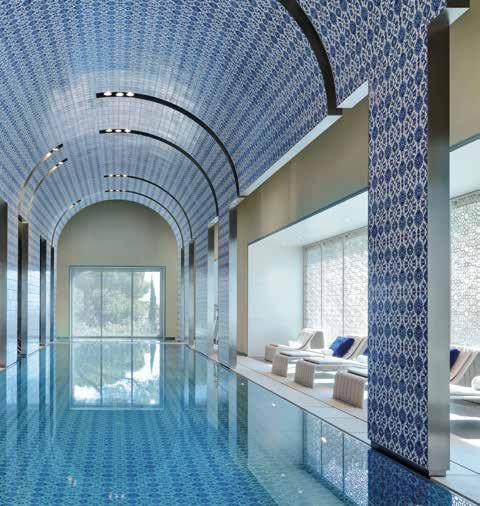
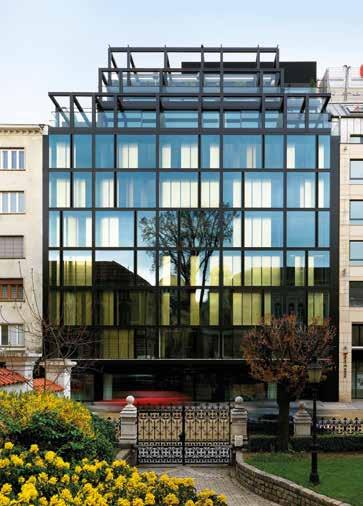
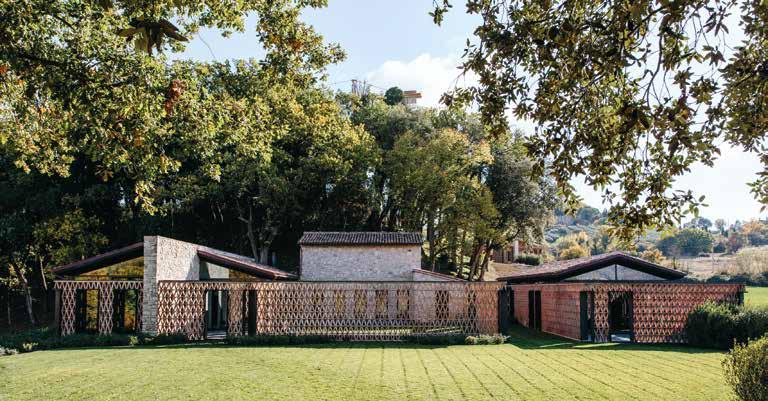
Top, a villa in the residential complex at Asproli, Umbria. Left, an interior in the restructuring project of an 18th-century villa in Positano where the architects are recovering traditional local materials and finding unusual ways to include them in the project
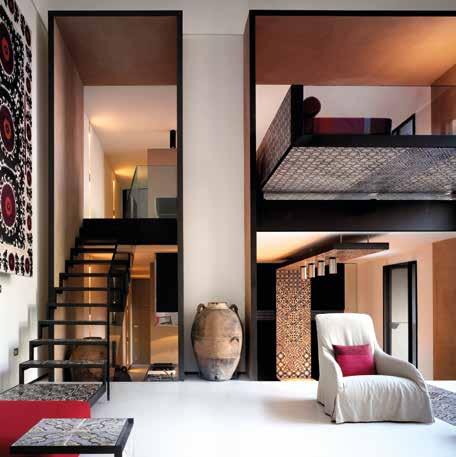
We look for a continuity between the two, so in a house we prioritise exposure to light and then introduce screening systems to modulate the light as desired”. In terms of materials Lazzarini and Pickering describe themselves as omnivores. “We happily make the switch between carbon fibre and embroidered fabrics. Everything’s on the table, whatever material fits so long as it’s rooted in the culture of the place and the client”. This choice is also evident on LPAdesigned yachts like Sai Ram, where the choice of fabrics was inspired by the client’s close link to India. The architects are also fascinated by how furnishing objects can be functionally transformed and superimposed. Take, for example, the cupboard doors in the Asproli residential complex, which when fully opened become shutters and close the homes from the inside, or the partition on the Magnum motoryacht that transforms into a table. With their latest project, the 37-metre yacht for Benetti’s Motopanfili series, Lazzarini and Pickering once again take to the sea. The yard’s brief was to evoke the memory of 1960s yachts. “These days yachts increasingly resemble houses, so we identified in the ribs a distinctive nautical character”. Lazzarini and Pickering also reinterpret this character through the eclectic, contemporary stylistic elements that inform all their diverse designs.
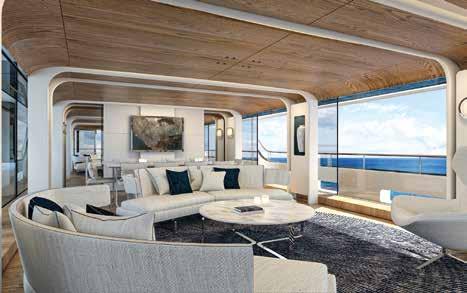
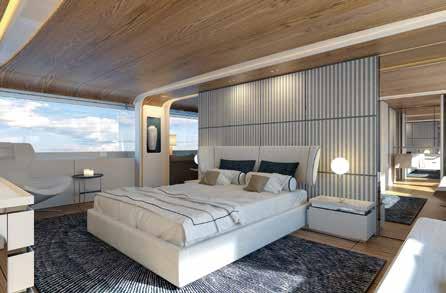
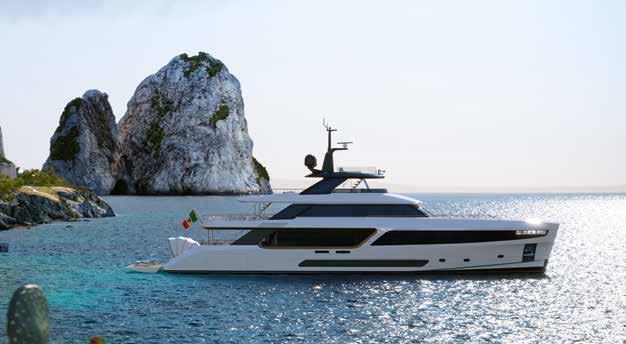
Left, the 37-metre Benetti motoryacht with exterior lines by Francesco Struglia. Claudio Lazzarini and Carl Pickering designed the interiors (above) like the inside of the skeleton of a great whale, with beams that add rhythm to the spaces. Below, right, the dinette on board Roma, a yacht that won a Compasso d’Oro honourable mention in 2008. Left, the bathroom in the glass cube on Benetti Sai Ram, an LPA design element that has achieved iconic status



An innovative, unconventional layout where the owner’s cabin is located at sea level. A 20-meter yacht with a high-tech approach, crisp lines and lots of glass. Design by Luca Santella and the Zuccon International Project studio, naval architecture by Lou Codega
by Paola Bertelli - ph. courtesy of Bluegame
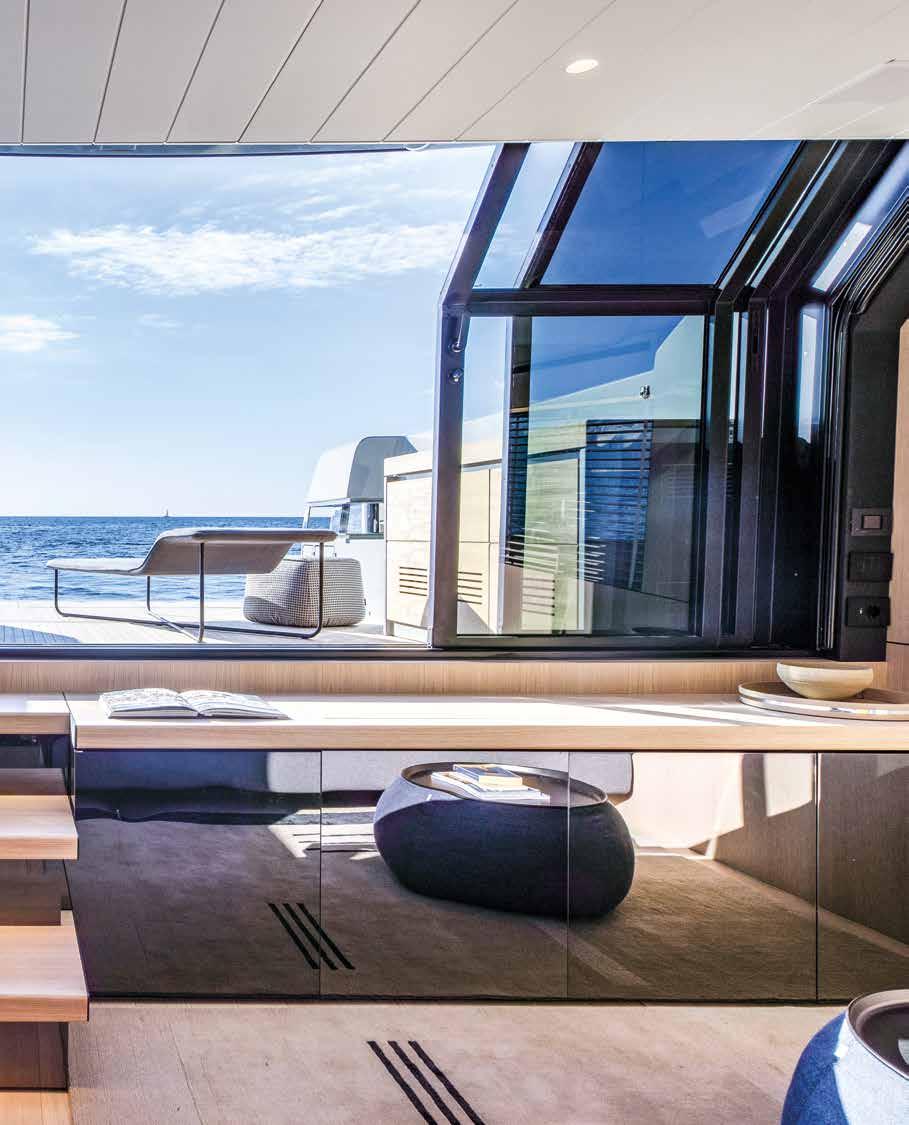
he yachting world is a rather traditionally-minded community where tried and tested ideas tend to be reworked but never overturned. Bluegame, a Sanlorenzo brand, has dared to disrupt this cosy conformity with the layout of its BGX60 (and previously on her big sister the BGX70), a startling new approach to designing on-board spaces. This revolution has been driven forward with enthusiasm, with spaces and walkways reshaped to highlight the sea’s presence in the interiors and create a close link between the owner and the marine environment. The heart of this transformation lies on the lower deck, traditionally a sleeping and technical area. Now it’s really a sort of main deck, spilling out onto the sea. Designed, in the words of brand CEO Carla Demaria, to be “owner centric”, the BGX60 not only has a spectacular lounge that dialogues directly with the beach area and the sea but also a spacious full-beam owner’s cabin amidships. These three spaces are key to the owner’s on-board life, linked in an uninterrupted flow that creates an intense symbiosis with the sea when under way or at anchor. The guest cabin is on the forward lower deck, and is accessed by a dedicated stairway from the upper deck. A second internal stairway links the lower lounge to the main deck and an external section of the beach area. On the upper deck, an all-glass structure with rigorous lines encloses an open space with helm station, galley and a second living area with dining table, while the two lounges are fore and aft. Lateral walkways connect these two areas, which are very different but complementary – the aft lounge/dining corner is intimate and sheltered, while the forward sun/dining is a fun, exuberant space. There is a straightforward sunbathing area on the roof. To offset the yacht’s compact dimensions the interiors are given an impression of greater space through the choice of a colour palette that lifts the natural and artificial light, which is reflected by glass and mirrored materials. The high-tech approach can be seen in the decor, a search for maximum functionality and attention to detail. The design of the lounge, for example, is very well thought-out. Here the sliding glass partition aft separating off the beach area contrasts with its equivalent further in the forward section which is partly covered by a mirrored surface that generates a greater impression of space and makes the stairway less obstructive. Given the yacht’s distinctive architecture, many of the furnishings are made to measure. However, there are some freestanding elements like the Poltrona Frau sofa on the lower deck and pieces by Paola Lenti in the exterior. The external lines are equally striking. This 20-metre build has a low profile with high bow, a shape sculptured with crisp, decisive surfaces accompanied by contrasting colour changes. The negatively-raked helm station windows recall those on board many working boats, further accentuating this yacht’s strong, masculine character. The BGX60 is, in fact, hard to place in the list of classic yacht types, falling as it does into a number of categories - explorer, walkaround, open, day cruiser and fisherman. The BGX60 project is the result of a collaboration between Luca Santella – an architect with a long experience of the sea, starting with sail yachts and participation in two Olympics, and founder of the Bluegame brand, which joined the Sanlorenzo group in 2018 - alongside Lou Codega, who handled the naval architecture, producing highly efficient hull shapes with excellent seaholding (the yacht can reach a top speed of 28 knots and cruises at 25 knots) and the Zuccon International studio, which was responsible for the exterior and interior design. www.bluegame.it
The close relationship between exteriors and interiors, accentuated by the almost endless windows, is one of this yacht’s great qualities. Opening, the lower deck lounge is on a slightly lower level than the beach area, which it is linked to it by a fully-opening glass door. The sofa facing the sea provides unique views under way and at anchor

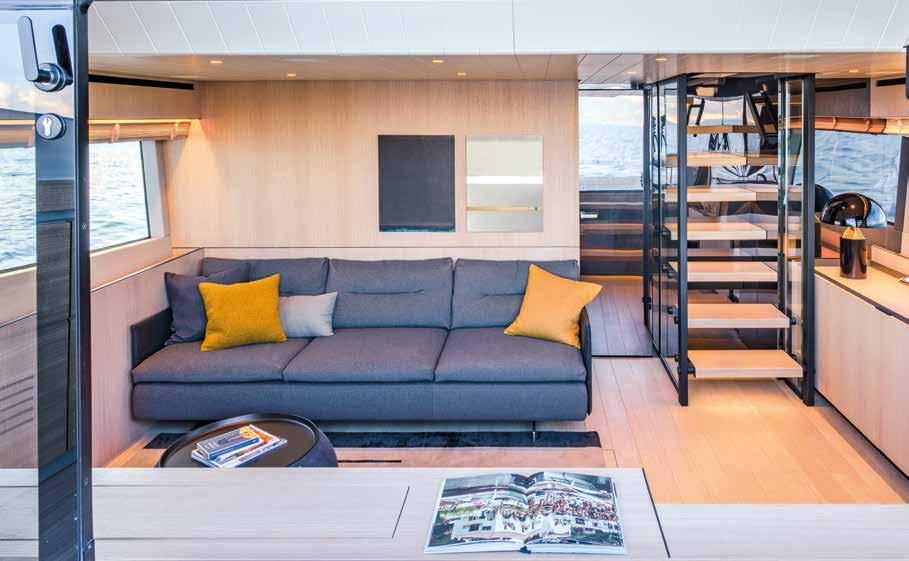
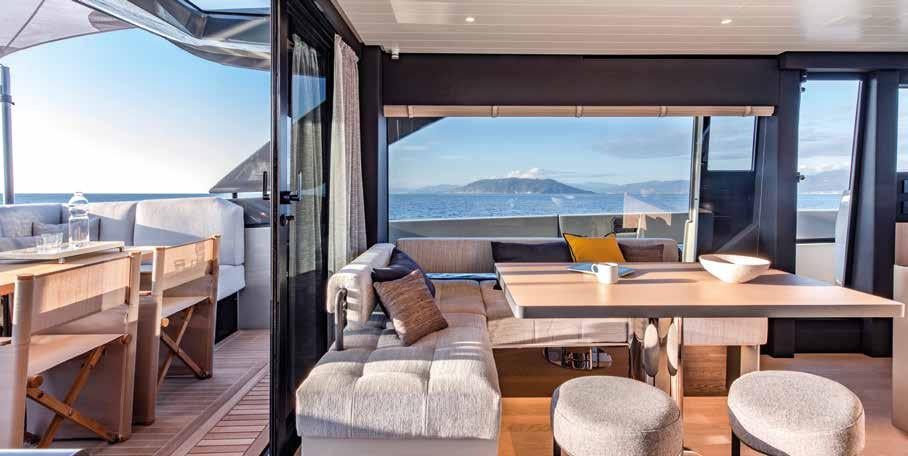

A modern, nautical design with extensive use of wood. Many of the furnishings were designed to measure, making best use of the on-board spaces. The two photos, top, show the lower deck lounge where the staircase is camouflaged by the mirrored walls behind it. Right, the fullbeam owner’s cabin and left, the two main-deck dining areas

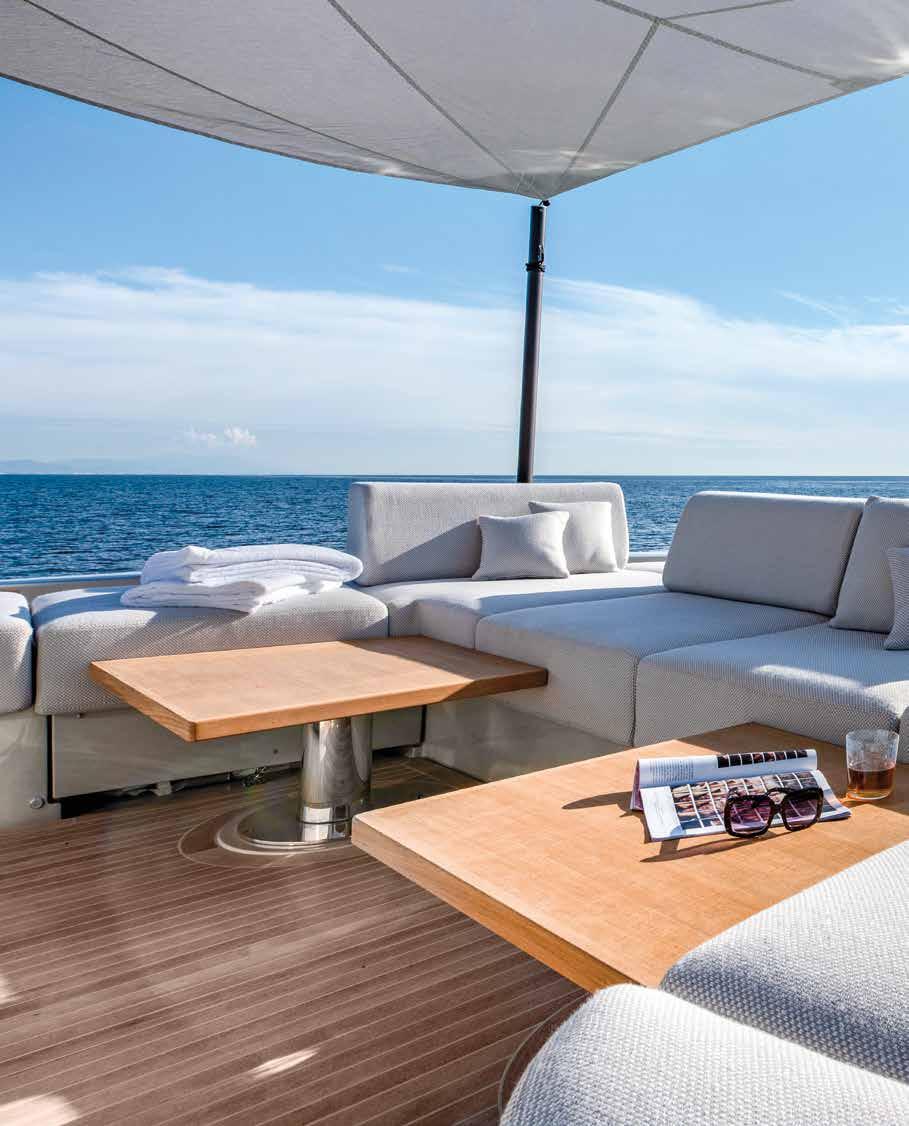
The forward outdoor lounge is spacious and versatile, with sunpads, sofas that can be converted by adjusting their back, and two coffee tables that can be transformed into a single large table

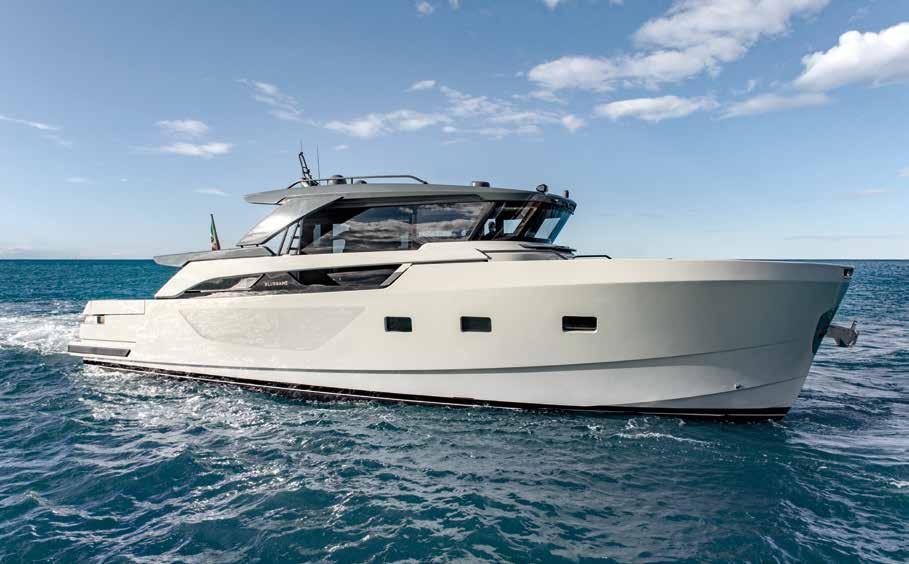
Concept Luca Santella, Chief Designer at Bluegame
Iwas born by the sea and I started sailing when I was a small child. As a sportsman and professional sailor I’ve covered a vast expanse of water, seen all kinds of craft and gained experience in every aspect of yachting. Bluegame was set up with the intention of doing something new – to create a synthesis between design vision and the authenticity of a no-holds-barred experience of the sea on a functional, efficient vessel occupying an exclusive niche in the market. The BGX60’s great strength is its innovative layout, reflected not only in the beach/saloon/owner’s cabin areas but throughout the yacht, creating unusual, attractive areas offering comfort and functionality, like the outdoor cockpit aft, the helm station and the lounge in the expansive bow section. The yacht has a low outline and centre of gravity together with an outstanding hull designed by Lou Codega, all of which means excellent performance and comfort. This is made possible by adopting an innovative approach to design and a commitment to the technical aspects of the build. It’s hard to decide on my favourite space – the helm station is an exciting place to be when you’re at the controls of the BGX60 in force 5 seas and the bow area is a wonderful spot for watching the sunset while enjoying an aperitif, but above all I’d choose to wake up early when at anchor and see the sea through the side windows of the cabin then go aft through the lounge, and once on the beach platform, dive straight into the water. This area is the secret of the BGX60’s success.

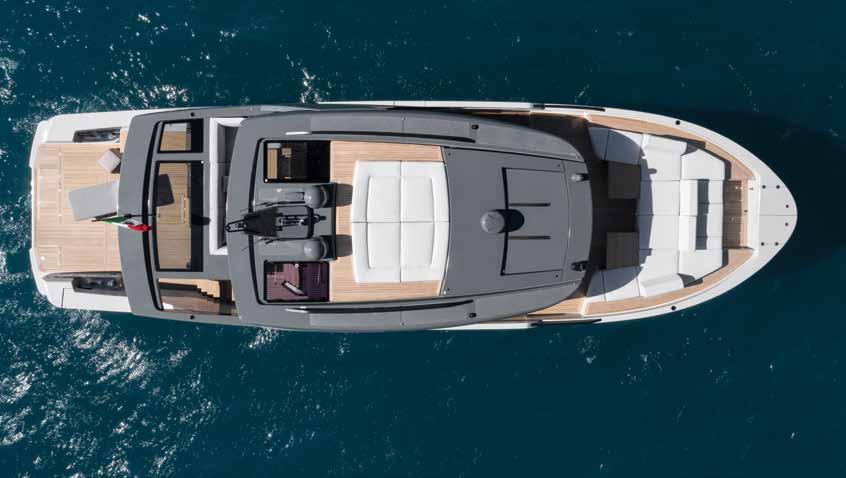
In the foreground of the photo above and below left, the minimal flybridge is designed for sunbathing in privacy. Below, right, the main deck cockpit. BGX60 has a low profile and centre of gravity. It is 19.02 metres long and has a 5.30 metre beam. It can be equipped with two 800 or 900 hp Volvo IPS engines that provide a top speed of 30 knots
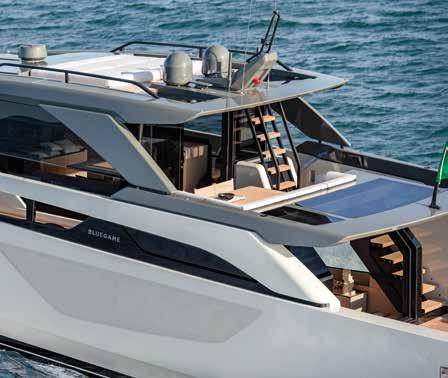

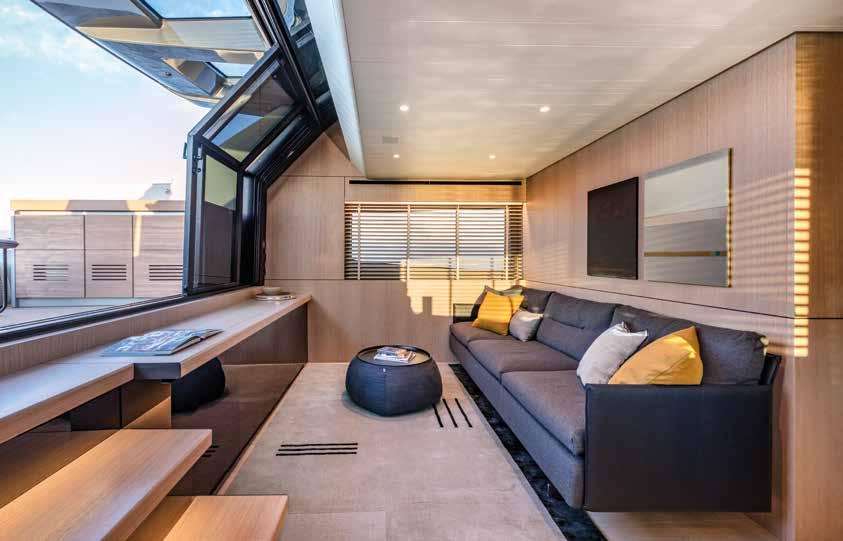
When the sliding glass door is open the lounge and beach area blend to create a single space. Behind this is the owner’s cabin (the two photos bottom, right) with lounge and walk-in wardrobe. Top right, the main deck has an open space layout with day area, kitchen, command console and extensive windows
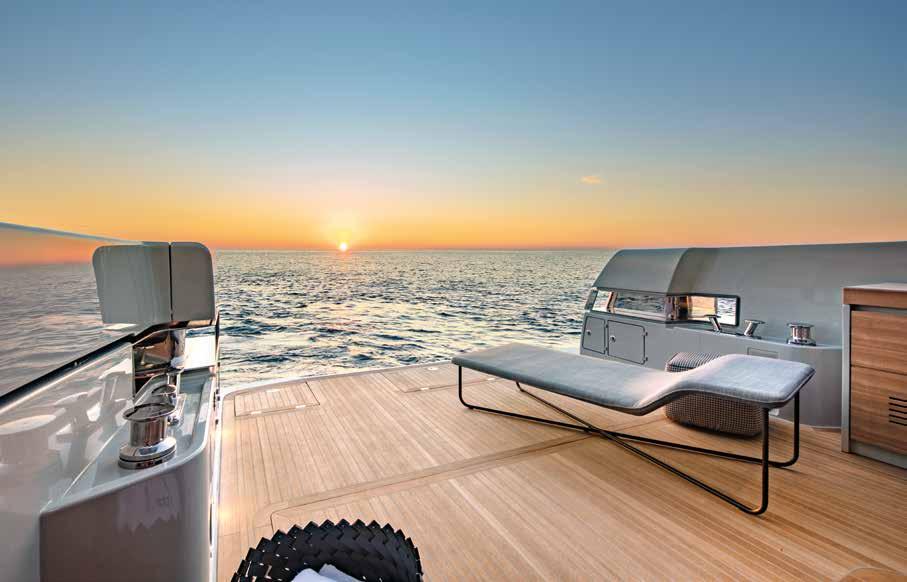
Interior and Exterior Design Bernardo Zuccon, ZIP
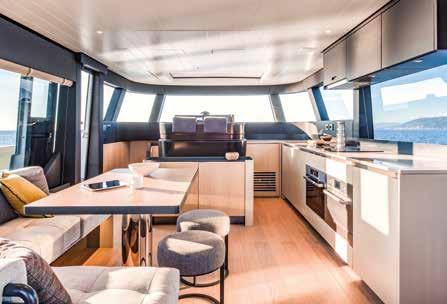
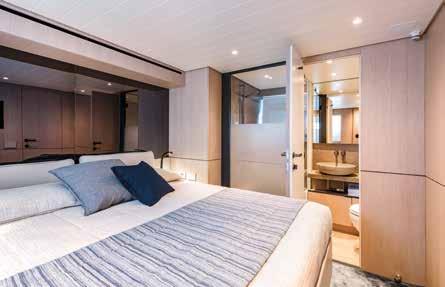
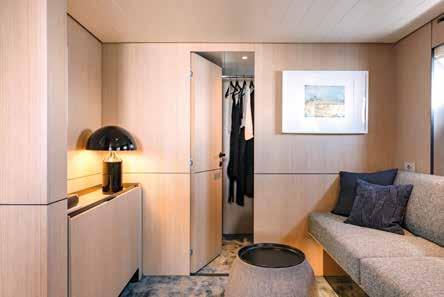

People and the sea are two fundamental concepts that express the essence of the world according to Bluegame. Its products are a synthesis of seaworthiness, performance and functionality, where every element is designed to provide that connection to the idea of voyaging by sea, “loving and fearing it” as great sailors teach us to do. With the BGX60 we’ve focussed on enhancing on-board life, providing privacy for the owner and guests. We also sought to emphasise the close link with the marine environment through our choice of materials and furnishings. We’ve used light-coloured wood extensively throughout along with natural fabrics that blend perfectly with the neutral tones of the furnishings. The result is a colour balance that is in perfect harmony with the marine surroundings. The architecture is designed to create large stretches of transparent surfaces that allow natural light to fill the interiors, adding a further element to the furnishings. However, we haven’t downplayed the value of artificial light – in fact, we’ve designed a lighting system that adds value to every interior at night, too. Its elements create a flow between the various spaces, reflecting the concept behind the architecture. Natural light plays a vital role in the lounge, with large glazed and mirrored surfaces enabling it to flood the surroundings, overcoming the confines between interiors and exteriors. The lounge enjoys a close contact with the sea, and here a large section of the forward bulkhead has a totally reflective surface, drawing the eye away from the bulk of the staircase with a play of reflections that enhance the perception of space in the interiors.
The Shipyard Carla Demaria, CEO of Bluegame
BGX is a daring line that enjoys the benefits of the path taken by Sanlorenzo that began with the revolutionary SX line – disruptive yachts with unmistakable lines and an iconoclastic approach to layout and walkways. Beyond any conventional classification I’d define the BGX60 as “owner-centric”. This model fully reflects the central role played by the owner. Privacy and conviviality become the owner’s choice, without ever compromising on a direct contact with the sea. All in all, the yacht is an attractive and original product, but what appeals most to our owners is the relationship between exterior and interior spaces, especially in the aft section. It also offers another crucial quality – safe, comfortable sailing in all conditions. The hull provides a perfect balance of weight and spaces around the centre of gravity, making the yacht surprisingly nimble and adding an extra dimension of safety. The special nature of this versatile yacht means our owners come from craft of all shapes and sizes. Bluegame owners, though, have one common trait - they are all expert yachtspeople with a deep knowledge of on-board life. Bluegame just keeps on amazing the world. Next August we’re unveiling the BG72, a result of our ambition to offer open yacht lovers all the comfort of a flybridge model. The revolutionary layout features an entirely open upper deck and a lower deck with access to the sea, creating a seamless continuity with the beach area, lounge and owner’s cabin. Owners no longer have to choose between the advantages of an open and a flybridge design as the new BG72 offers both.


[ BESPOKE ] ON SHOW AS WORKS OF ART
Climatised wine cellars have become spectacular display cases for their contents, bespoke design furnishings that are beautiful, functional and ideal for showing off prestigious on-board wine collections by Désirée Sormani
On board the 50 m Overmarine Moonraker there are four wine cellars divided by type of wine. The owner wanted them in a contemporary style to complement the yacht furnishings
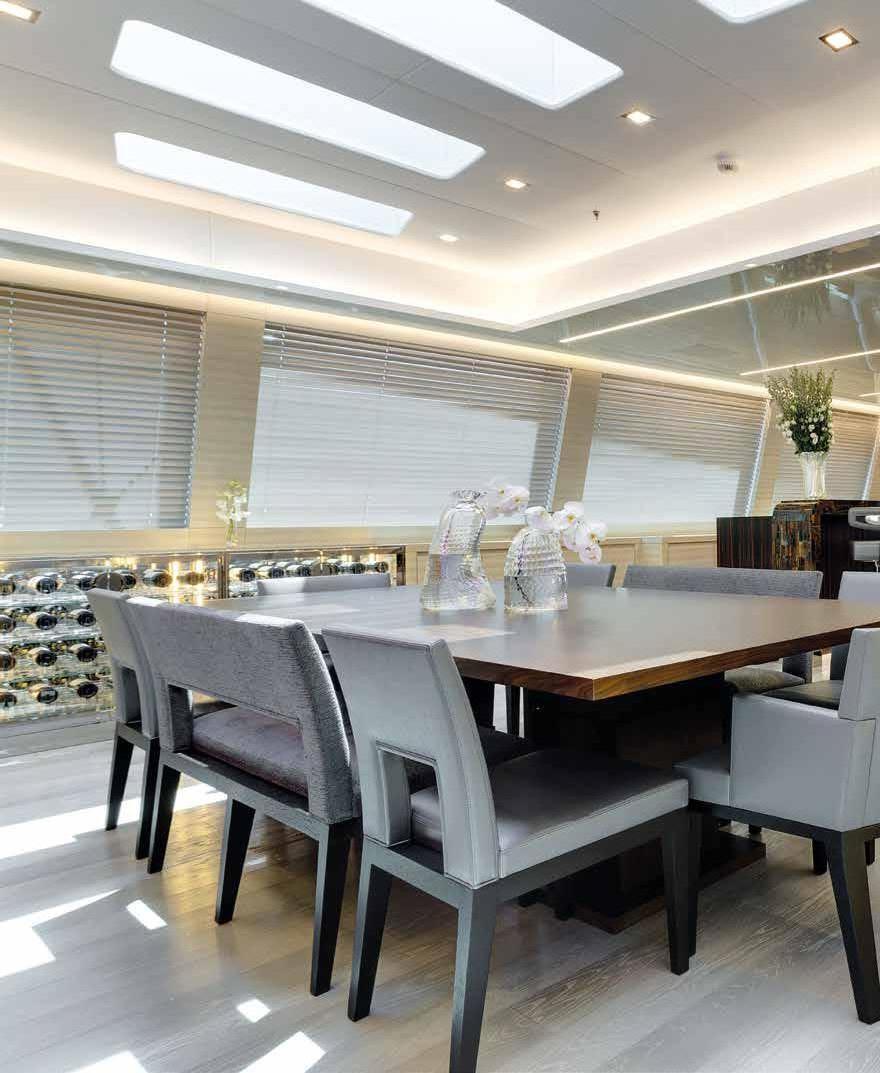
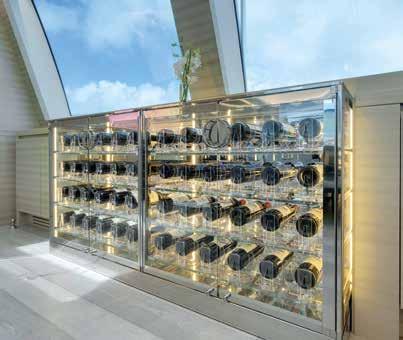
What could be better than being on board the only yacht in a lovely bay at sunset in the company of the right people, sipping a glass of fine wine or expensive Champagne at just the right temperature? To make the most of such sublime moments, many connoisseur owners who are lovers of fine wines would like their yacht to provide a suitable place to store their personal wine collections on board - and now the yacht’s wine cellar has become not only the perfect place to keep different types at the correct temperature but also a lovely design object that enhances its surroundings as much as or more than a marvellous bergère chair. Nowadays wine cellars are increasingly being seen as not only functional but lovely to look at, objects to admire as a work of art on full display in the lounge, the beating heart of the yacht’s social life. The results of this trend can be seen on Overmarine’s 50-metre Moonraker, with two glittering, transparent furniture units created in the same style as the yacht itself along the lounge walls. They were made by Esigo, a company founded in the Veneto region in 2007 and now expert in the bespoke manufacture of refrigerated wine cellars for all settings from 5-star hotels to elegant restaurants, spas and, of course, luxury yachts. Bespoke design is entirely focussed on details, and all are made to measure on the basis of the owner’s desires using the most select materials with a variety of finishes, from metal to precious woods, textured finishes and gold leaf, all applied by master artisans. The result is remarkable works of art to stand in front of, admire - and then enjoy the contents! www.esigocustomwinecabinet.com
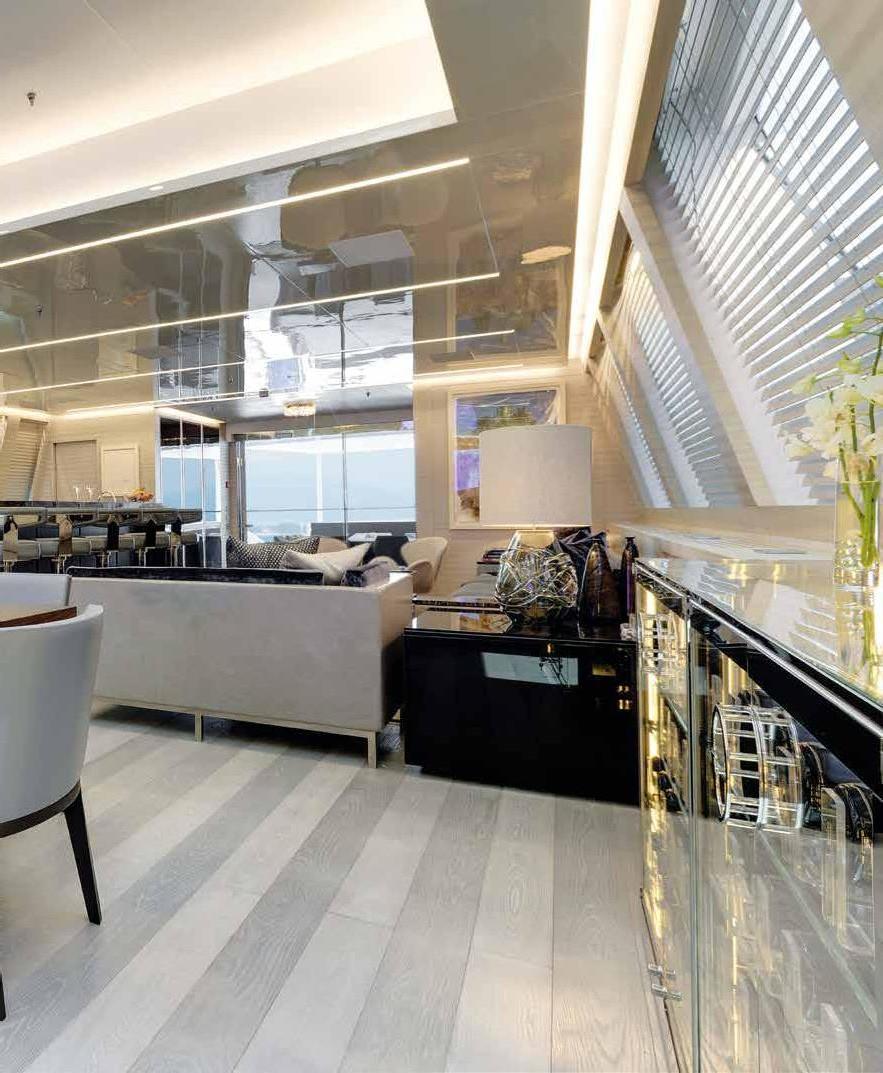
[ ON-TREND MUST-HAVES]
The first pictures of the ANN2 released by Manta Aircraft. This two-seater has eight ducted fans, four of which can be tilted. Energy will be provided by a gas turbine. It has a number of possible uses, from emergency response to rapid VIP transpor


THE WAGER OF THE CENTURY
A new product type in the aeronautics industry, eVtol craft are a hybrid between flying cars and dronetype control systems. Big consultancy companies are convinced that a new market for flying transport will have developed by the year 2040, rethinking the entire aviation concept from zero
by Sergio Barlocchetti
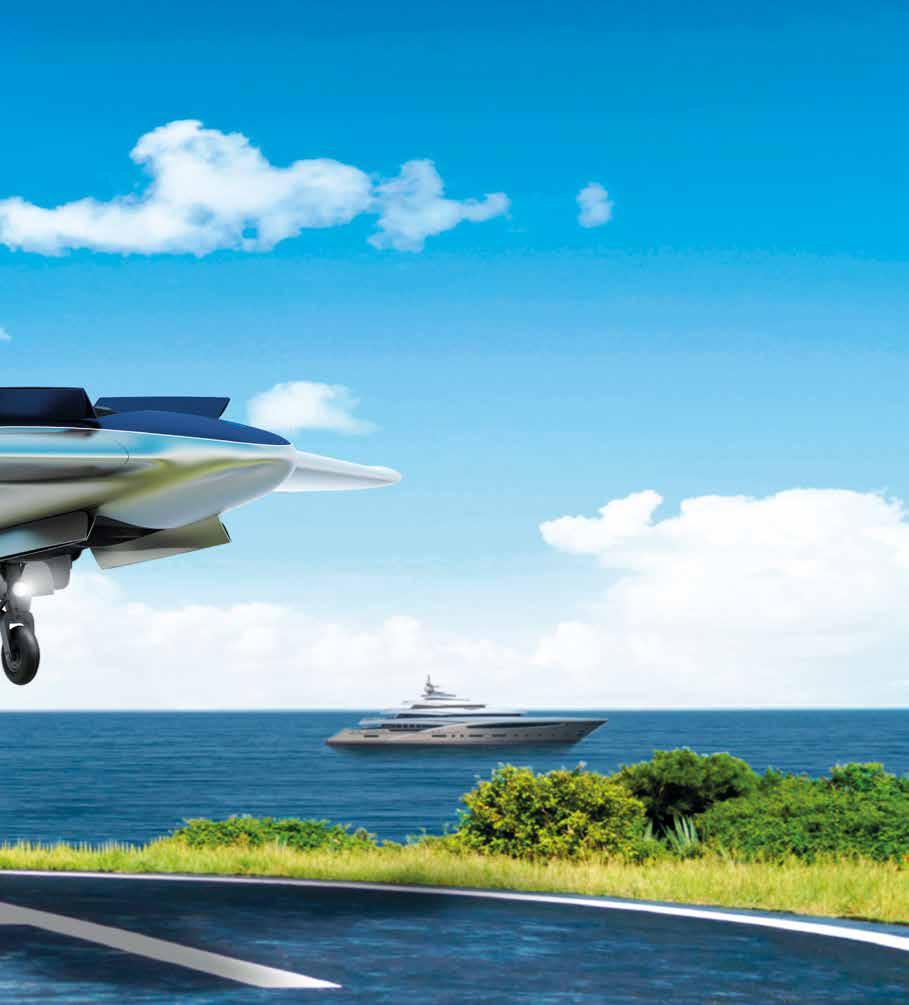
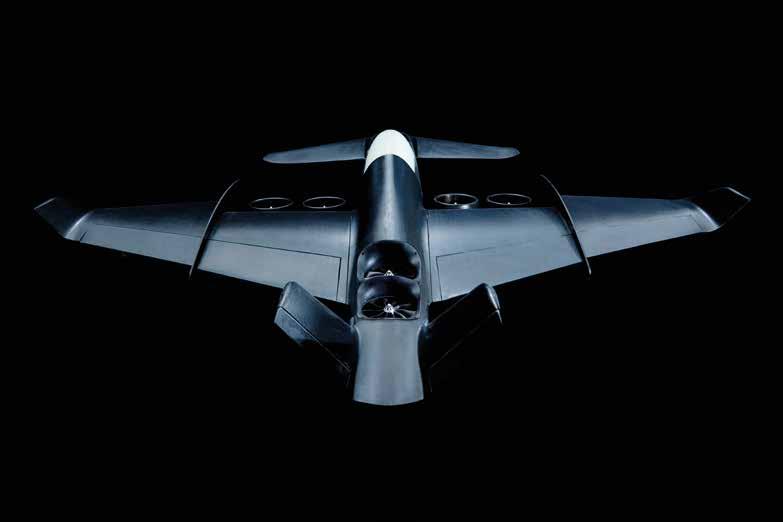

There are many good reasons behind the enthusiasm for eVtol that is driving industries and investors to risk their money in this new business, but before describing their motives we should first take a look at these new aircraft. The term eVtol is short for electric vertical take-off and landing, a new generation of vehicles for the ecological revolution in urban transportation. The eVtol craft are the result of combining flying cars, with around twenty types constructed over the past 50 years, with control systems based on drone technology. At the moment 30 or so companies, a mix of startups and established businesses founded a decade ago, are working in the field, and some are helping the authorities develop a regulatory framework. From the point of view of business opportunities there are at least four good reasons to take the plunge in this sector. The first is that converting personal transport into a more ecologicallysound solution has attracted significant research funding, with the EU posting a figure of 5.3 billion euro for the period 2021-2027. Secondly, whoever is first to certify their personal transport technology will dictate future standards and own the patents for a control system or an ergonomic solution. Third, eVtol aircraft means manufacturers can abandon the classic aeronautical configurations, the traditional shapes made familiar in conventional planes, helicopters and dirigibles, introducing transparent cabins, sofas instead of seats and flying rooms where passengers can change while in flight. Finally, research leads to lower fares. After Hyundai and Uber, now Stellantis has got together with California’s Archer
The prototype of the eVTOL by Joby is based on a multicopter configuration with swing rotors. It is one of the projects at the most advanced stage of development

[ ON-TREND MUST-HAVES ]
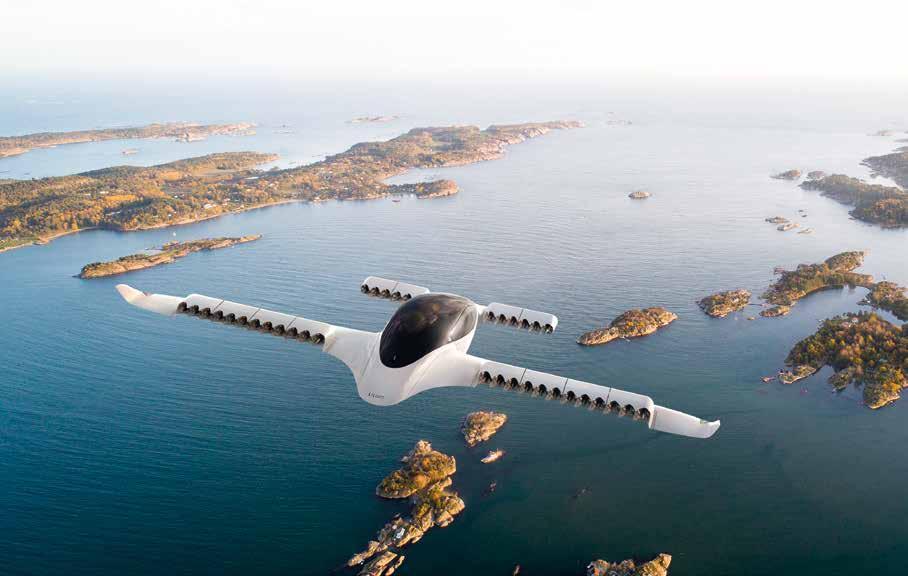
company to enter the eVtol industry. Archer would like to see large-scale production of its aircraft commence in 2023, although this may be rather optimistic. As well as the big car manufacturers, established aerospace companies have also been making moves, like Boeing with its Aurora project, Airbus with Vahana, Pipistrel with Vertical Solution, Lilium, Manta Aircraft. Many others are joining in but at a slower pace. The most effective way to identify the best flying taxi to invest in is to examine the background of the people leading the new projects. If they have tried and tested aerospace experience and are ready to abandon conventional aeronautical ideas they will probably succeed in finding the right conceptual mix and achieve outstanding results. Archer, for example, has taken on Geoff Bower as chief engineer. Bower was previously number one in the Airbus department that designed the Vahana, an eVtol aircraft that has already been authorised to undergo test flights. Financing has also come from Marc Lore, president and CEO of Walmart’s electrical operations. The UN also supports the idea we will be hopping aboard airborne taxis and crossing cities in pilotless craft, predicting that by 2050 almost three quarters of the Earth’s population will be living in cities. Large consultancy companies like Morgan Stanley are convinced that a new market with an overall value of 1,500 billion dollars will have developed by 2040. Rethinking aviation from zero is, of course, a positive factor, and the idea of travelling in a roomy cabin directly from the yacht’s deck to land half an hour later in the city centre appeals to us all.
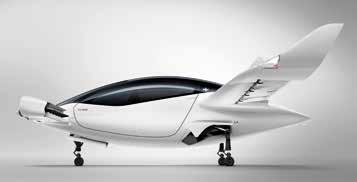
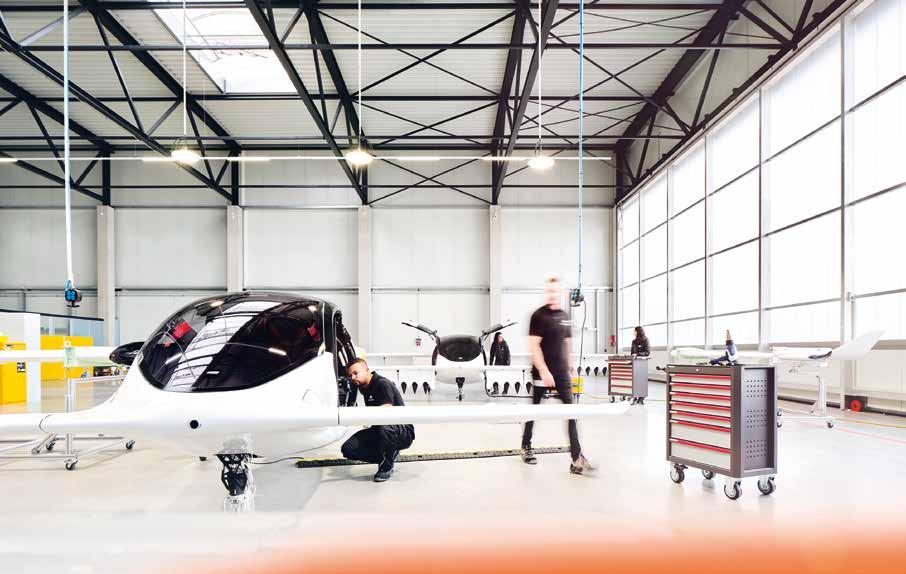
From Germany, the Lilium Jet is designed as a personal mobility vehicle. It has a totally electric propulsion system and a cabin that can accommodate five people. The first demonstration flight took place in May 2019
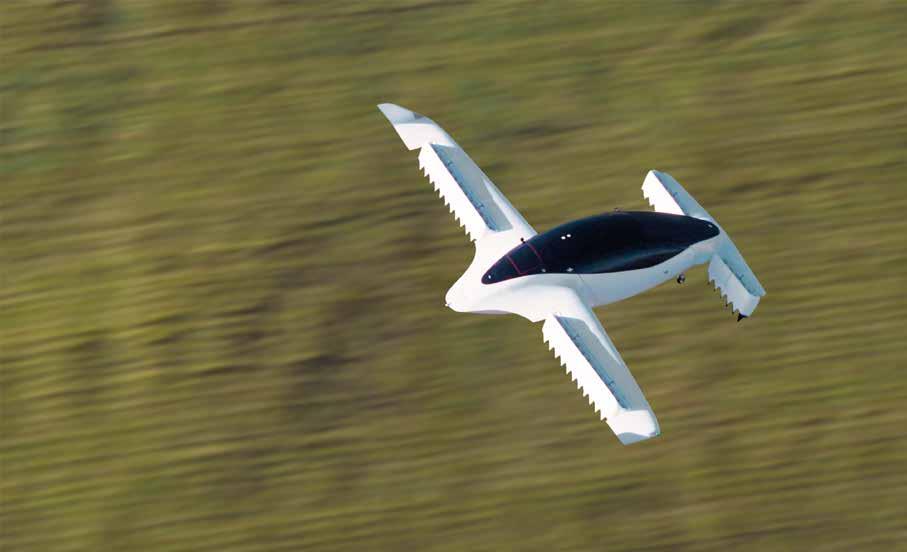
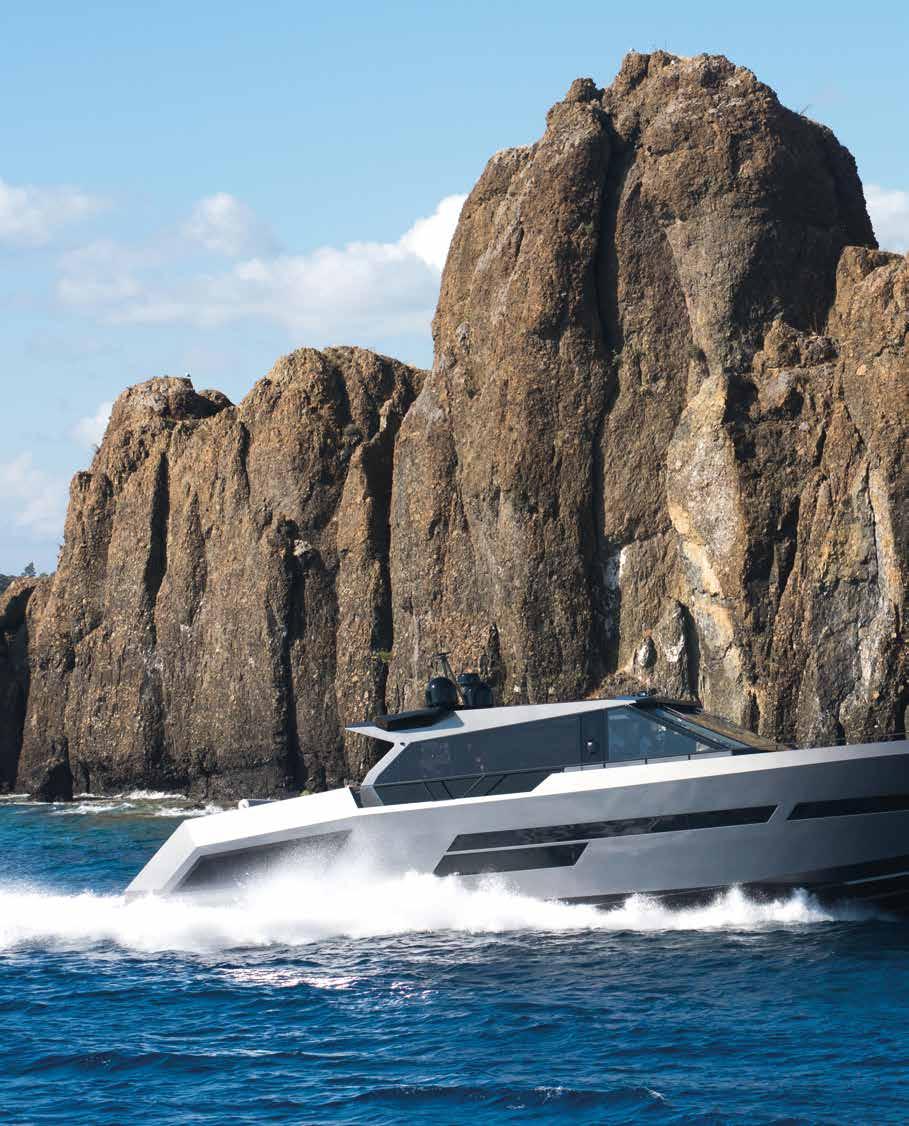
FAST, FREE, EDGY: BULLETPROOF
Thanks to an angular glass deckhouse and black elongated hull windows, the first Mazu 82 cuts a startlingly masculine dash as it whips along at 40 knots. An excellent chaseboat in the making that sends out just the right message of speed and power
by Mary Hegarty
As rugged as the rocky shore behind them, the Mazu 82’s in-house hull lines strike the perfect balance between top speed, seakeeping capability and fuel efficiency. While the ideal choice for zipping from mother ship to shore and vice versa, an impressive 400nm range opens up broader horizons toorem
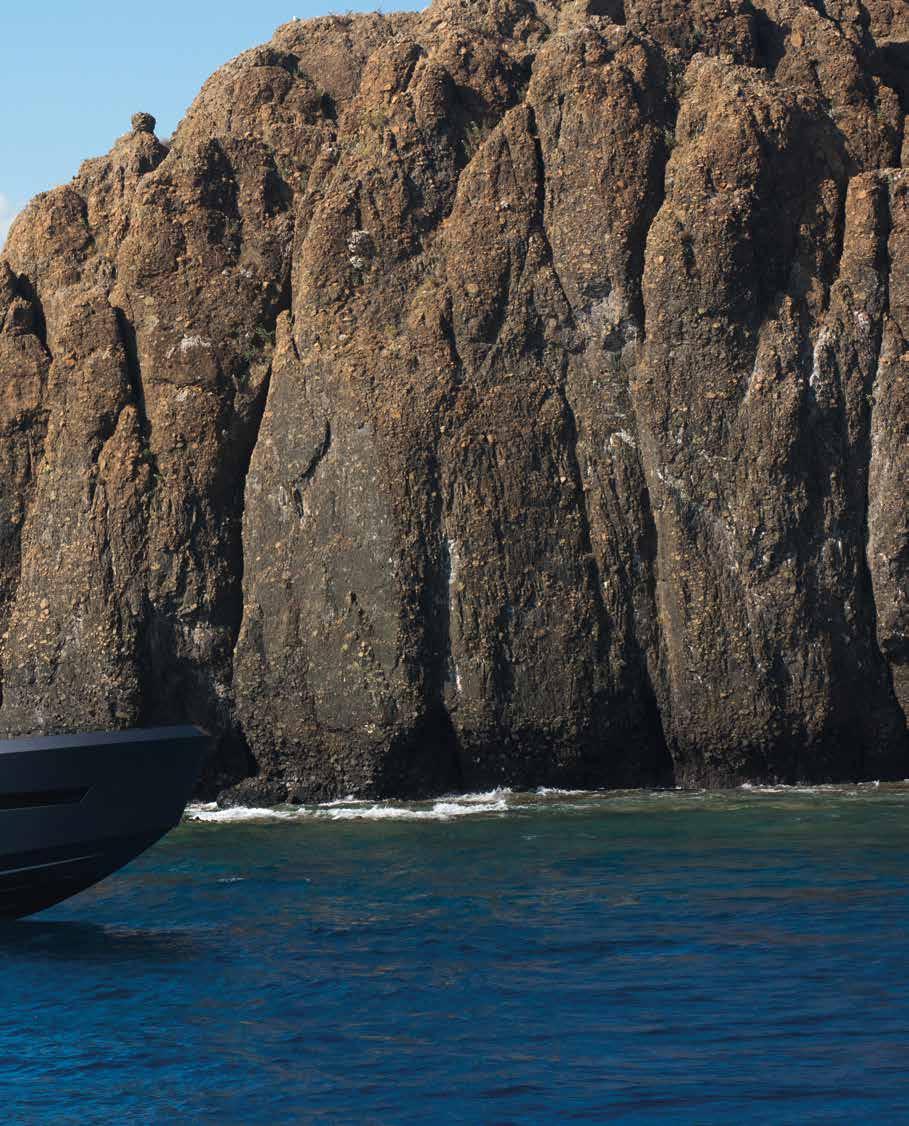
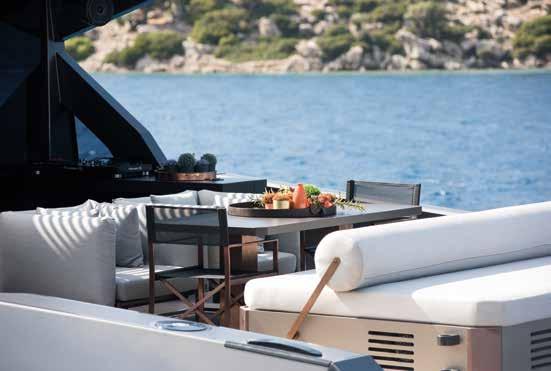
The dark, sleek Mazu 82 gracefully and swiftly executes a very tight turn and it’s hard not to gasp as its stunning all-glass deckhouse suddenly glints in the sun. An angular creation made mostly of one-piece glass panes, it has to be one of the edgiest designs on the market right now. No wraparound windscreen here but instead a flat angled surface made from tempered, laminated 22mm thick glass with a PVB interlayer that is quite literally bulletproof. Very chic, very James Bond. Perfect for quick getaways in all senses of the term, the Mazu 82 unleashes a blistering 40 knot redline speed with carefree ease too. The Turkish yard designed it to give the feeling of being aboard an authentic superyacht, yet in its 25m LOA, this new beauty also offers the glamour, convenience and ease of operation of a fabulously masculine chase boat. A pretty unbeatable combination. Built from dark carbon-fibre composite with a lightweight sandwich construction, this is a strong, stiff craft with a deep-vee hull that packs an 18-degree deadrise at its stern and a 28-degree deadrise at the bow. That 40-knot top speed should come as no great surprise. An ability to cruise effortlessly at 33 knots will be more good news to superyacht owners – the Mazu 82 will ever get left behind! Nor will it guzzle fuel. “The hull lines were designed in-house to provide a perfect balance between top speed, seakeeping capability and fuel efficiency,” says Halit Yukay, lead designer and CEO of Mazu Yachts. “At cruising speed the yacht has a range of just under 400 nautical miles or around 12 hours cruising.” Clad in a cool grey livery, the Mazu 82’s flush main deck is topped by that futuristic deckhouse with extra clear glass for zero distortion and reflections. Natural ventilation comes thanks to three opening portholes at the front of the superstructure, while a sliding aluminium roof enhances the airy, loft-like feeling on the main deck. The aft deck has been stepped all the way down to the swim platform, a bespoke flourish added at the request of the owner who has just taken delivery. The steps include a built-in sofa and are wide enough for guests to stretch out on to sunbathe or simply hang out and chat. The forward section is equally guest-friendly. “Multifunctional design was very important for the owner,” says Yukay. “In fact, the open foredeck has three different uses: as a sunbathing area, a dining area for 12 people, and an open-air cinema.” But despite that edgy first impact, the Mazu 82’s bespoke interior has a timeless feel, very much a deliberate choice as Mazu Yachts’ philosophy is that freedom itself is timeless. It also marks the yard’s first collaboration with an outside designer, Tanju Özelgin. The celebrated Turkish pen has created a sense of comfort, ease and absolute peace aboard with a colour palette that spans muted greys and browns. A set of lit steps seem to float downwards to the lower deck where a large white sofa pops out beautifully from the otherwise subtle colour scheme and the occasional splash of red adds verve. The master suite is modern and sleek, yet once again, those muted colours create a feeling of retreat, space and tranquillity. The same Zen-like ambience is in evidence in the VIP stateroom and the twin cabin. www.mazuyachts.com
This page, a bird’s eye view through the open aluminium hard top, reveals the steering position and galley as well as providing a glimpse of the lower deck. Note also the spacious foredeck minus its furnishings and large screen. Opposite page, a close-up of the al fresco dining and lounging area aft

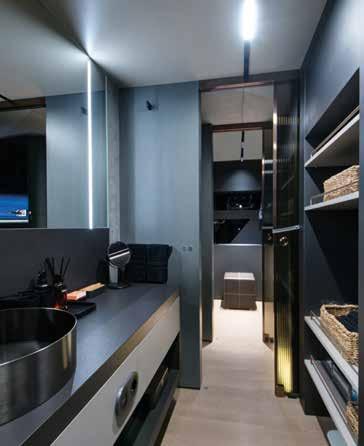

A carousel of delights: this page, the master stateroom and the VIP as well as a bathroom give an idea of the Zen-like interior ambience. Facing page, the versatile Mazu 82’s stepped transom complete with built-in seating and an al fresco dining area on the foredeck that also doubles as a home cinema




STRENGH AND POWER
Robust, with crisp, rigorous lines, the Heritage aluminium maxi tender by Reale Yachts has strong personality and offers plenty of opportunity for personalisation. With the most powerful 900 hp engine option it can reach 55 knots by Paola Bertelli
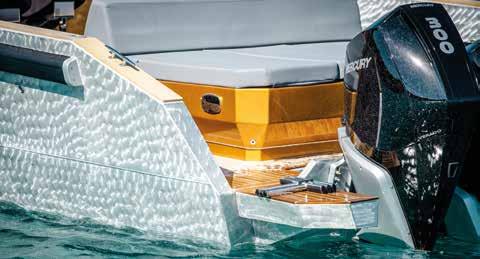
The Heritage is a muscular seagoing maxi-tender. The “raw” aluminium and mirror-polished bow create a rugged, racy look. Its 3.77-metre beam provides spacious fore and aft sunbathing areas and a three-seat helm console
With an aluminium hull and mirror-polished bow, Heritage is a 9.9 metre day-cruiser with a 3.77-metre beam, decisive lines and clean, rigorous look, built by Real Yachts with the aim of creating the perfect tender for the explorer models in its portfolio. As with its yachts, the emphasis on a “custom” concept is also clear on board this walk-around with central console and T-Top that can also be configured in Open and Cabin versions. There is a huge range of liveries to choose from, and the material used for the details, accessories and the versatility of the aluminium, a light, ecologicallysound, recyclable material that generates no waste during construction enables modifications to be made even after purchase. The high, sheer sides provide protection and make it possible to exploit every centimetre. Combined with the ample width they create generous areas with sofas and sunpads. The wide bow section means that the forward area gains unexpected space. This configuration also deflects spray, making the boat very dry when under way. Together with the hull design, this width is also a valuable design element providing stability and comfort when the Heritage is at anchor. The craft’s decisive look and rugged character are not only a result of its design – taking control at the helm generates a white-knuckle adrenaline surge. It’s a powerful, high performance yet responsive boat that reveals its full character when powering through the waves, offering a smooth ride and making safe, sharp turns. It can be equipped with two or three outboards for a total of 900 hp, and can reach a top speed of 55 knots. Stern drive engines can also be installed on request. www.realeyachts.com

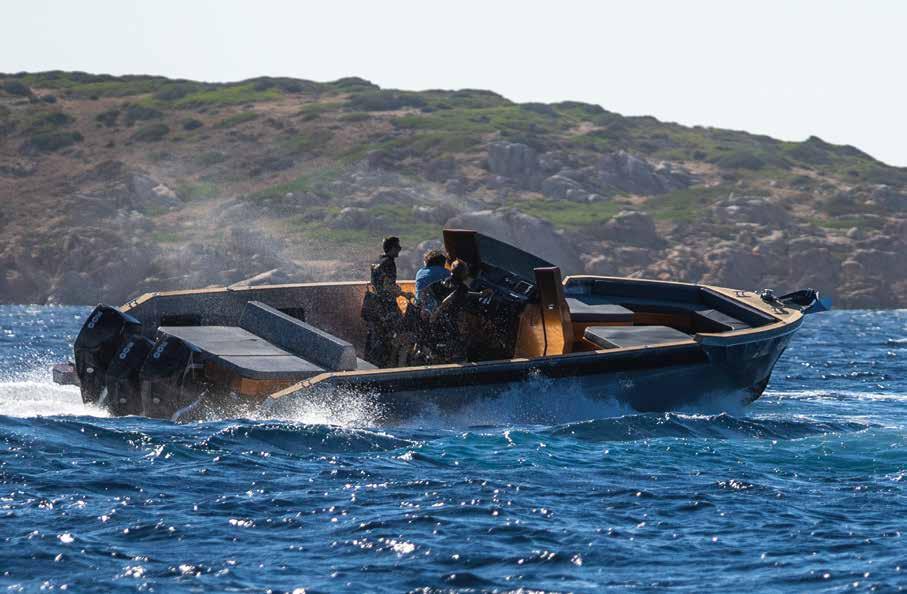
The upper section of the hull, which can be personalised from a vast range of colours, is given a coating of nano-technology paint to protect the aluminium from corrosion and overheating in the sun. It can be powered by two or three outboard motors

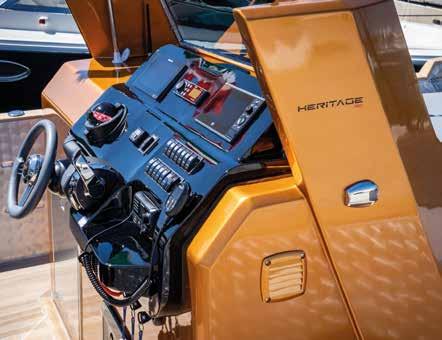
NICO LAUDE, CEO REALE YACHTS
Reale Yachts is a young yard, but draws on the experience of experts from the naval, yachting and merchant sectors. Founded in 2018, it specialises in explorer yachts with the Pacifico line, to be followed by a new trawler version called FastCruise. Based in Pisa, it builds 100% custom yachts between 22 and 50 metres in length, mostly in steel and aluminium. This July Reale yachts is to launch its first Pacifico 32 and another five craft in the Heritage line, introduced last summer. What is Reale yacht’s mission? It’s all in the name – Reale (“royal” in Italian – ed) isn’t referring to something aristocratic, it’s about being making real, concrete and totally custom products for clients who want something more than series models. That’s why we only use steel and aluminium, which are far better than fibreglass. What are the distinctive features of your builds? We offer a range of explorers built on naval platforms. We haven’t carried over the naval platform usually chosen for yachts of 60 metres and above into our 25-30 metre offer – our core business is producing limited numbers of unique yachts. Buying a Reale yacht means visiting our yard and seeing a sheet of aluminium that will become your yacht. We always design our craft with outstanding volumes, as the length doesn’t matter much if the spaces are sacrificed. The most immediately striking feature of a Reale build is its width. Our 32-metre, for example, is 8.32 metres wide and has a GT of 320 tons, well above the average. A wide beam is a Reale hallmark. How did the Heritage project come about? It was conceived when we considered the requirements of our explorer yacht owners, but it’s been favourably received by the market as a whole. In fact, the 2021 production of six tenders had already been sold by November 2020, but Covid has forced us to reduce this to four. The refined design is complemented by outstanding performance and quality. Of course, it’s entirely personalisable, and is in aluminium. One simple example will show the level of build quality – to make it we weld an impressive number of aluminium sections. There’s a huge gap between this and a fibreglass build in terms of quality and safety. What are you most proud of in the new Pacifico 32? It’s a true explorer, a wonderful challenge embodied in a yacht whose variablegeometry hull means it can handle extreme seas and weather. It has a range of 5,000 miles and can remain at sea for at least three weeks. It has incredible spaces and provides total comfort with a minimum headroom of 2.15 metres and thermal/noise insulation throughout. It’s a floating villa with crisp, rugged lines, the exterior of a true explorer and luxurious interiors. What are you working on now? We’re developing a 22-metre yacht, the first model in our fast cruiser line, in aluminium, glass and wood. It’s already winning acclaim, which makes us very proud. It’s a fast yacht that can sail equally well in displacement and planing, our interpretation of the trawler for the new millennium.
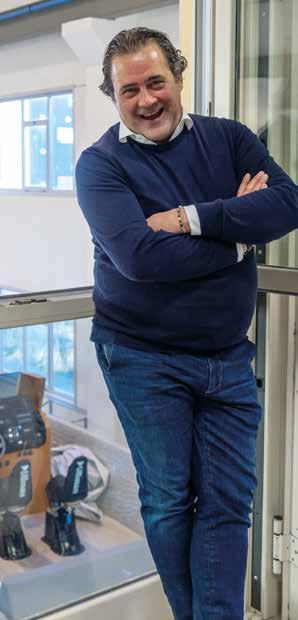
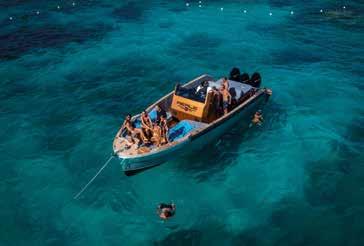
PEDALLING IN STYLE
There seems to be an almost infinite variety of fitness training equipment available these days, but some producers have worked on the assumption that these machines should also be beautiful design objects, to be displayed as well as used. The Fuoripista Bike, for example, is an embodiment of beauty and function
by Désirée Sormani
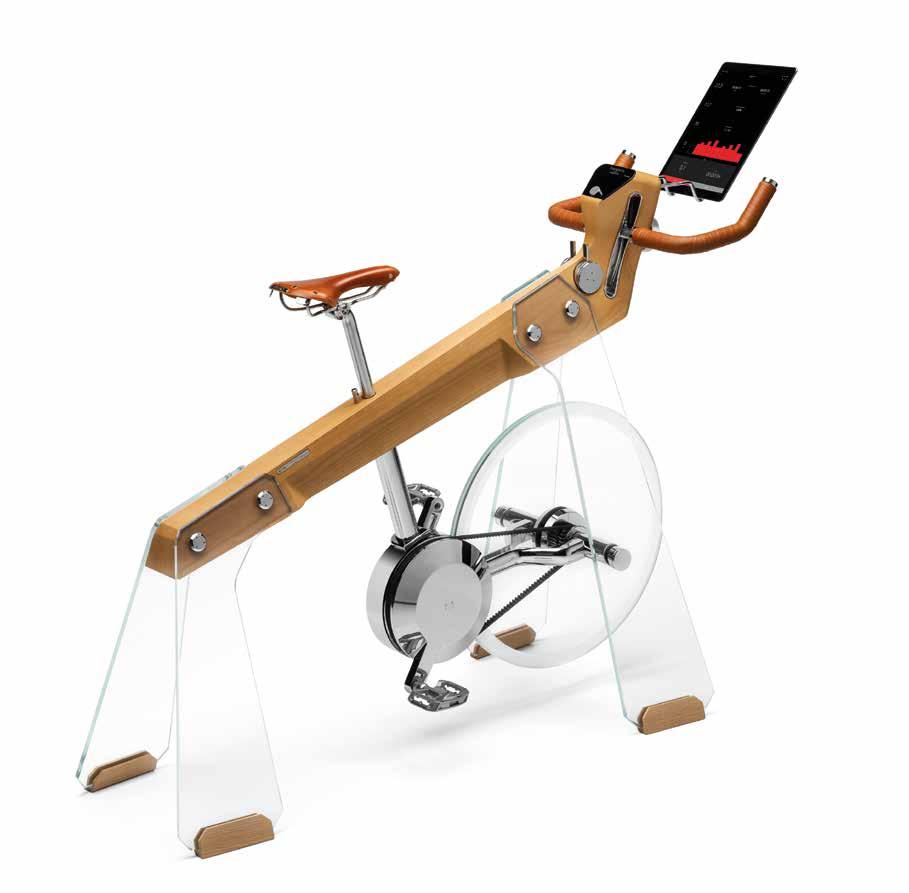
Fuoripista is a smart-bike: a dual communications protocol interacts with all apps, software, computers, cyclocomputers, smartphones and tablets in wireless mode
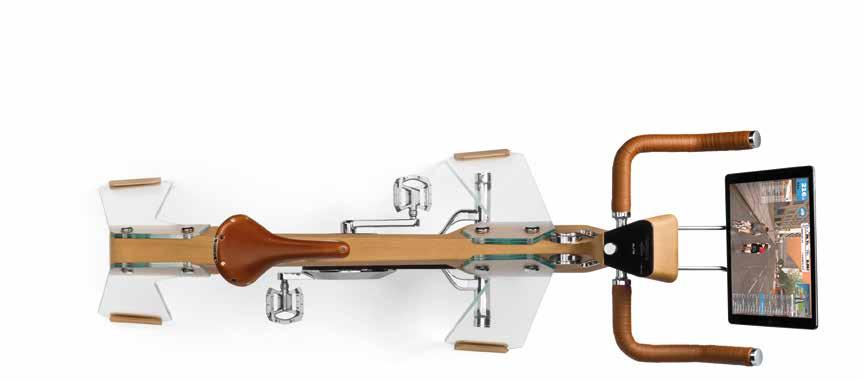
Keeping fit has never been so important. This applies to on-board life, too, and yachts often carry a large number of toys so that guests can spend happy hours in pleasurable activity - not only splashing about in the sea! When it’s done on equipment with an unusual, attractive design then training crosses over into style and status. Fuoripista Bike is an unusual, highly original product from a new brand launched by ELITE with consultancy by Adriano Design. It’s the result of a different approach – hence the name Fuoripista, or off-piste – complementing ELITE’s experience with an unusual way of interpreting sports activities, combining a concept of well-being with lifestyle. Its design and warm, high-quality materials enable the Bike to stand out from traditional sports equipment, transforming it into furnishing object, a sculptural element that can be placed anywhere, even in the lounge or under-cover outdoor areas. The Bike is made of ash, tempered glass, aluminium, steel and leather, with great attention lavished on even the smallest detail. These select materials have also been chosen because they are natural and sustainable. The 50 cm flywheel, weighing 15 kg, is also made of glass. It is one of the largest flywheels in the indoor training world and enables the Bike to create a hyper-realistic simulation of the ride, especially during high-intensity workouts. The main body is in solid ash given a closed-pore multilayer treatment with a water-based varnish that makes it waterproof. The handlebars and saddle are clad in real leather. In conclusion, the Fuoripista Bike provides an opportunity to follow personalised routes and training programmes as well as real, virtual or GPS routes. It also enables users to train with a virtual coach according to preset objectives or to connect with the training community and pedal online with other cyclists, making exercising fun and not just a solo activity. www.elite-it.com

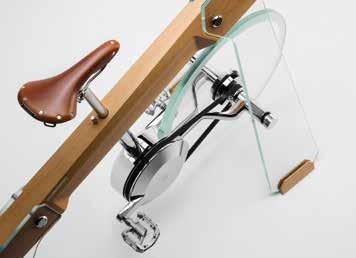
Made of solid ash, tempered glass, aluminium, steel and leather, the Fuoripista Bike has an unusual, eye-catching look
The Polo Skeleton by Piaget has an integrated steel bracelet that can quickly be swapped over for the leather strap provided
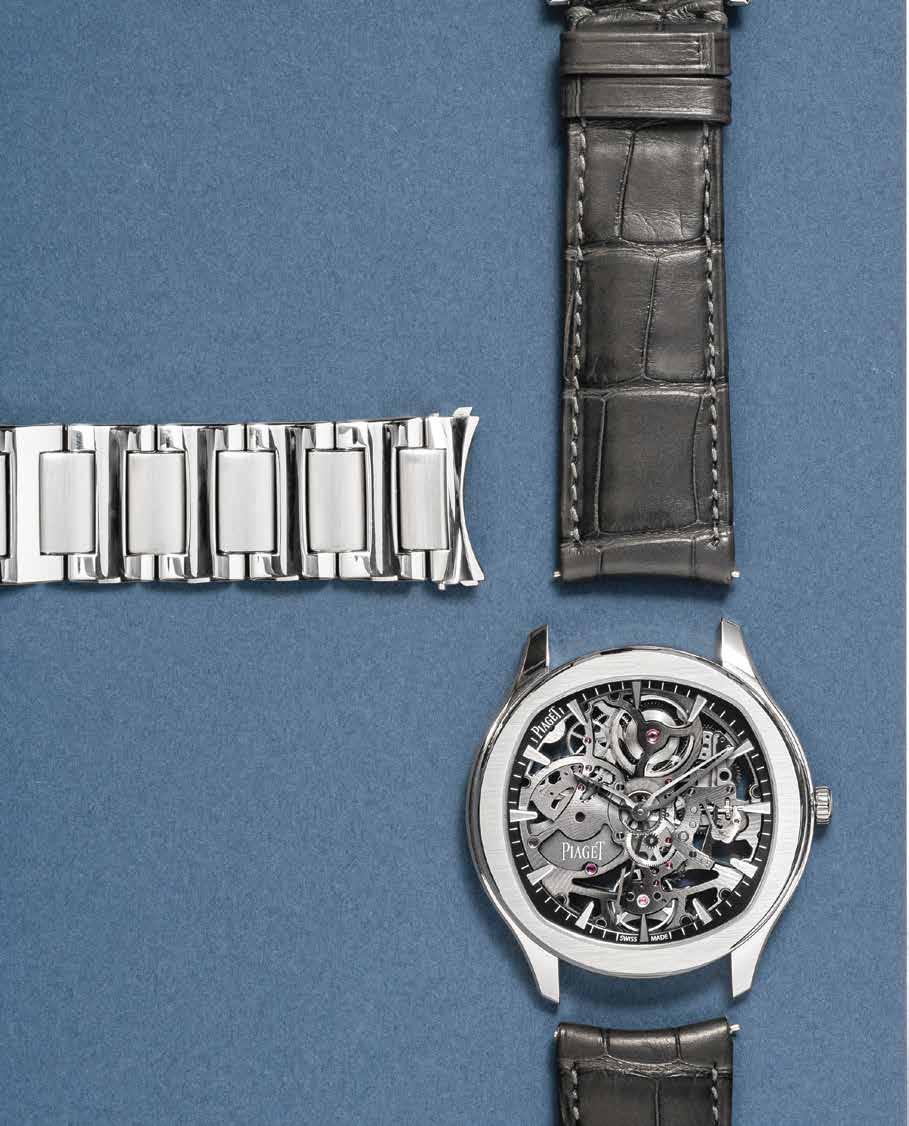
The Mechanics of The Soul
Making the invisible visible. Adopting an aesthetic that rejects the superfluous to test the limits of the physical. That’s the philosophy behind Polo Skeleton, a slimmed-down version of Piaget’s iconic sports watch
by Diego Tamone

To side, the back showing the architectural skeletonised structure of the automatic Calibre 1200S1. Below, a precise design drawing. Opposite page, a view of the model
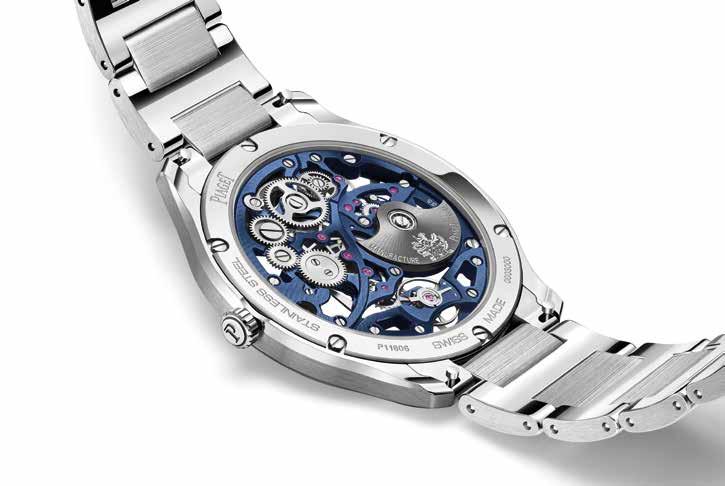

Adding detail and enhancing value by removing material. This fascinating contradiction has inspired the skeletonised frame, an embodiment of the art of subtraction, a rare skill practiced exclusively by the watchmaking world since the 18th century. At one time wonderfully ornate and baroque, now robust and architectural. Evolved, reimagined, reassessed in design and manufacture. What was once the fruit of artisanal genius and meticulous piercing and shaping by hand, it is now produced by advanced design software and the efficiency of sophisticated numerically-controlled machines. What hasn’t changed, though, is the spirit behind what will always be a complication mastered by only a few. Daring for the sheer pleasure of display and the power to amaze. It’s an attitude that’s familiar to Piaget, a brand with an established design heritage of skeletonised watches dating back to the 1970s. The expressive language of the Polo Skeleton is a perfect demonstration of technical and stylistic expertise – this sport watch has a 42 mm steel case but is only 6.5 mm thick, has a rapid-change bracelet and automatic in-house movement. Ultra-flat and essential, deliberately stripped down to display the watch’s spectacular mechanics. www.piaget.com
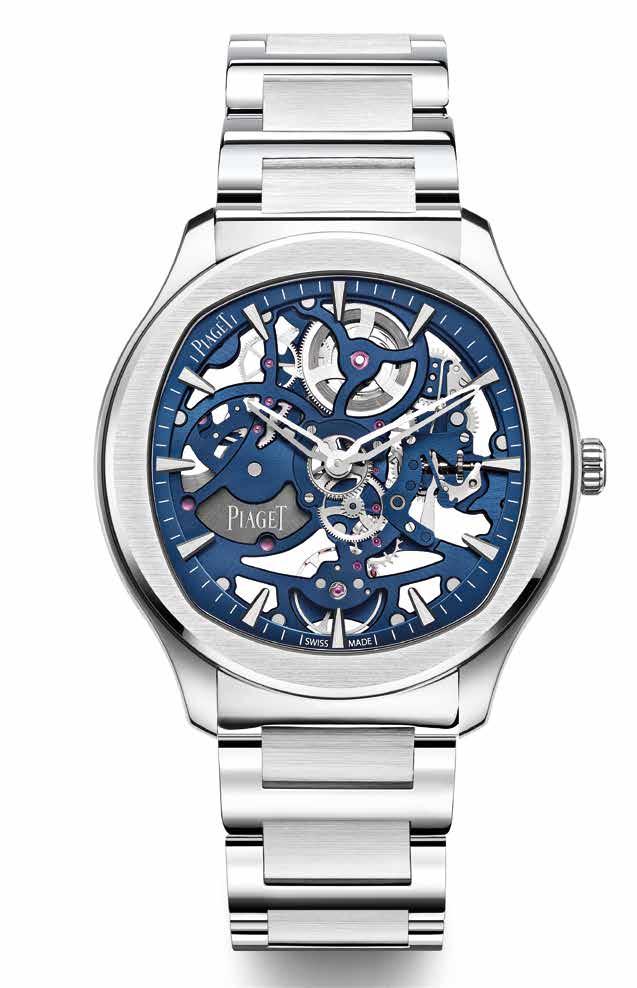
THE SEA
ON THE SKIN
Imagination is the watchword for jewels that seem to have been plucked from the depths of a tropical sea. Isn’t salt on the skin one of the most pleasant summertime feelings, a sensation we long for during the long winter months? Now these jewels will help us clothe ourselves in the pleasures of summer even when the season has yet to arrive, giving free rein to our imagination and wearing fish, jellyfish, octopuses, starfish and seahorses that will carry our thoughts to the most beautiful, liberating season of the year and allow us to flaunt what pleases us most with freedom, irony and imagination
by Beatrice Galbiati
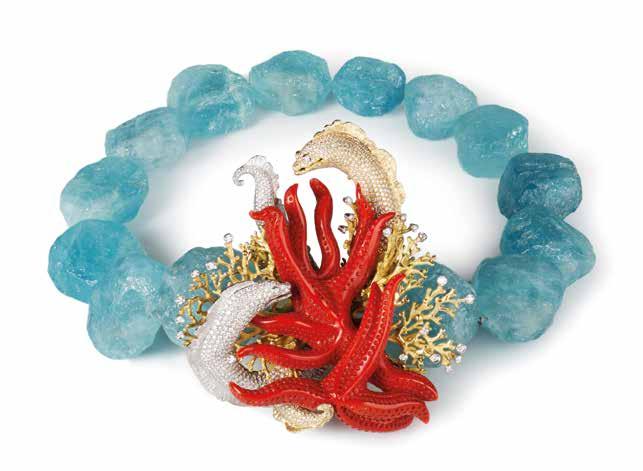
Brazilian Aquamarine, brilliant-cut diamonds, deep red “moro de Sardegna” coral starfish and white gold for the Danza delle Murene necklace by Massimo Izzo

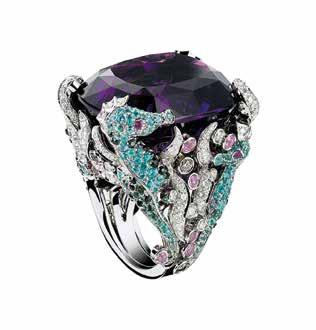
1. Coral, diamonds, sapphires and white and yellow gold for the Mini Marinella Jellyfish earrings by Chantecler 2. White gold, diamond, amethyst, paraiba-type tourmalines, pink sapphires, blue tormalines and rubies for the Hippocampe Ring, Dior Joaillerie 3. Rose gold, sapphires and diamonds for the fish pendant by Leo Pizzo 4. The Octopus ring by Roberto Coin is in yellow gold with brown and coloured 5. From the Nesea collection, earrings with starfish in white coral and diamonds by De Simone


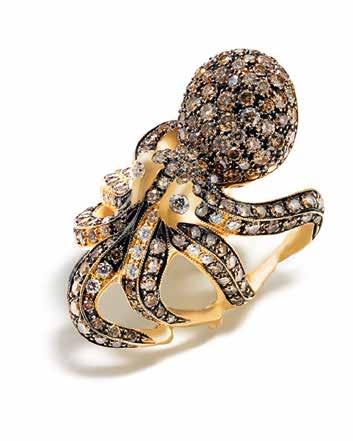
REINVENTING BEVERLY HILLS
Carefully curated cosmopolitan living is set to reinvent the Californian lifestyle for the next generation. Gardenhouse is planting seeds and breathing new life into this exclusive and celebrity-favoured corner of Los Angeles
by Roxanne Hughes


Gardenhouse places residents within minutes of Los Angeles’ most acclaimed attractions. From the world-class shopping of Rodeo Drive to the iconic nightlife of the Sunset Strip and the beaches of Santa Monica
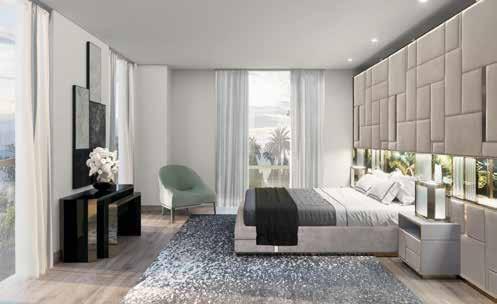

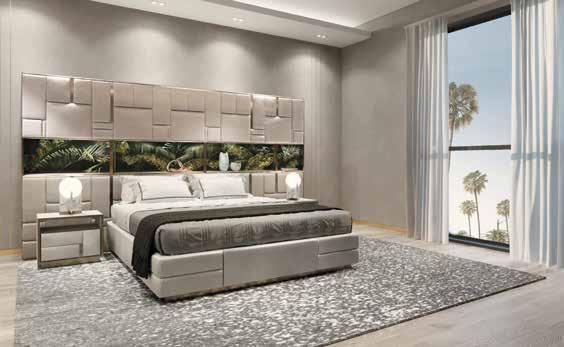



Each distinct property come fully equipped by Visionnaire with the latest in sophisticated, sustainable style
Gardenhouse is the much-anticipated American debut of the world-renowned Ma Yansong (MAD Architects, China). Partnering with Visionnaire, the Italian lifestyle brand, the team have set out to create turnkey residences for California’s time-poor, cash-rich, discerning clientele. Comprising Sky Villas, Row Houses and Garden Flats, Gardenhouse intends to establish a community that will reinvent the essence of Beverly Hills for a new generation. The architecture and the natural landscape have been purposefully partnered to inspire inhabitants to live life more harmoniously, in what has been described as ‘enlightened urban living’. Gardenhouse has transformed the boulevard streetscape with its ‘village on a hill’ design, establishing itself as a unique collection of 18 architecturally inspired, aspirational homes. Quite literally, the development is breathing new life into its location. Gardenhouse features the largest ‘living wall’ in the US amongst its many accolades, and the buildings encircle a lush central atrium. The concept offers respite for homeowners from their hectic lives, and reminds them of their human commitment to the natural environment. The development has succeeded in partnering the indoor and outdoor living spaces with free-flowing dynamic whilst simultaneously
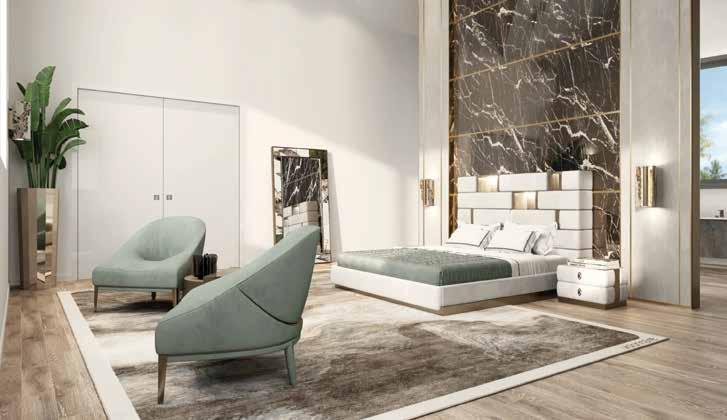
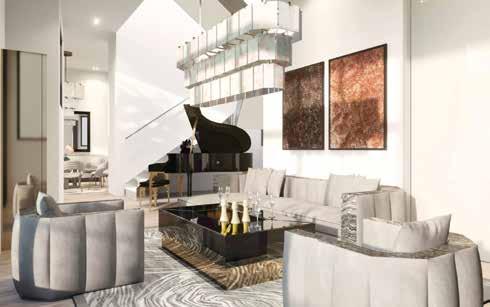
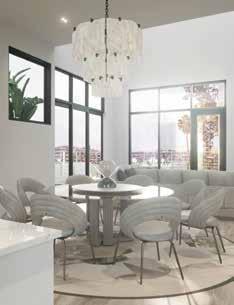
Prospective buyers can further their environmental consideration by electing for the supply of only FSC certified wood
highlighting the juxtaposition between the two. With seamless transitions between inside and out, residents enjoy expansive openconcept floor plans with towering walls of glass. The properties come fully furnished, equipped by Visionnaire with the latest in sophisticated, sustainable style. The contemporary designs are tailored to suit each individual residence, with a refined sculptural modernism that has versatility at its core. Highlights of the Gardenhouse development include Michele Astolfi artworks featuring leaves in green mosaic glass studded with Swarovski crystals, kitchens of Michelin-chef calibre with Miele appliances, and Japanese onsen-style wet rooms with freestanding bath tubs. The Garden Flats are one-storey, three-bedroom properties with private balconies and terraces. The three Row Houses comprise three storeys in a ‘town house’ style and benefit from private entrances from the boulevard on the south side. The Sky Villas occupy the top floors of the white gables and span two storeys, connected by a statement staircase. The Sky Villas take on a penthouse personality and boast both an abundance of natural light and expansive views across the city. Elevators connect the subterranean parking garage with a lobby, which is open to the sky and surrounds a reflecting pool. https://gardenhousebh.com

theoneyd.com platinummedialab.com
EDITOR IN CHIEF Barbara Del Duca
PUBLISHER Deborah Bazzoni deborahbazzoni@platinummedialab.com
MANAGING DIRECTOR Désirée Sormani desireesormani@platinummedialab.com
ART DIRECTOR Laura Larese de Santo lauralarese@platinummedialab.com
EDITORIAL STAFF Beatrice Galbiati (Jewellery Editor) beatricegalbiati@platinummedialab.com
CONTRIBUTORS Sergio A. Barlocchetti (Aviation), Marta Bernasconi, Paola Bertelli, Marta Gasparini, Mary Hegarty, Roxanne Huges, Andrea Pezzini, Diego Tamone (Cars and Watches), Micaela Zucconi (Art)
TRANSLATIONS Mary Hegarty, Chris Thompson
DISTRIBUTION FOR ITALY AND ABROAD SO.DI.P. “Angelo Patuzzi” S.p.a. Via Bettola, 18 20092 Cinisello Balsamo (MI), Italy ph. +39/02-660301- fax +39/02-66030320 - e-mail sies@sodip.it
ADVERTISING Deborah Bazzoni (Sales Director) ph. + 39/02-36683420, mobile + 39/335 6282058 deborahbazzoni@platinummedialab.com G. Giraldini (Sales Rapresentative Rome) mobile + 39/335 396138 sales.giraldini@gmail.com Ilaria Valerio (Furniture & Luxury Goods) mobile +39 335 8027816 ilariavalerio@platinummedialab.com
PRINTING GECA SRL Via Monferrato, 54 20098 San Giuliano Milanese
SUBSCRIPTION SERVICE ph.: + 39/02-36683420 (Italy’s office hours) abbonamenti@platinummedialab.com subscriptions@platinummedialab.com platinummedialab.com
BACK ISSUES Double the cover price + delivery costs
NEWSSTAND DISTRIBUTION The ONE Yacht & Design is distributed in the major newsstands and airports in the following countries: EUROPE: Italy, Austria, Belgium, Czech Republic, France, Germany, Great Britain, Greece, Luxembourg, Netherlands, Poland, Portuga, Principality of Monaco, Slovenia, Spain, Sweden, Switzerland. AMERICA: Brazil, Canada, United States. OCEANIA: Australia, New Zeland. MIDDLE EAST: U.A.E. United Arab Emirates, Qatar, Oman,Turkey. ASIA: Japan, Hong Kong, India, Maldives, Seychelles, Singapore, Thailand, Taiwan ALTERNATIVE DISTRIBUTION The updated list of our distribution among Platinum Media Lab’s premium partners can be found on our web site platinummedialab.com
All rights reserved for Italy and abroad The One, Registered at the Milan law court n° 22 - 30/01/2015
PUBLISHER
Via San Calimero, 1 20122 Milan Italy ph. +39/02-36683420 a.r. - fax + 39/02-36683421 info@platinummedialab.com
CEO Matteo Galbiati matteogalbiati@platinummedialab.com
EDITORIAL DIRECTOR Barbara Del Duca
Platinum Media Lab publishes the following international magazines
Wonder atches













